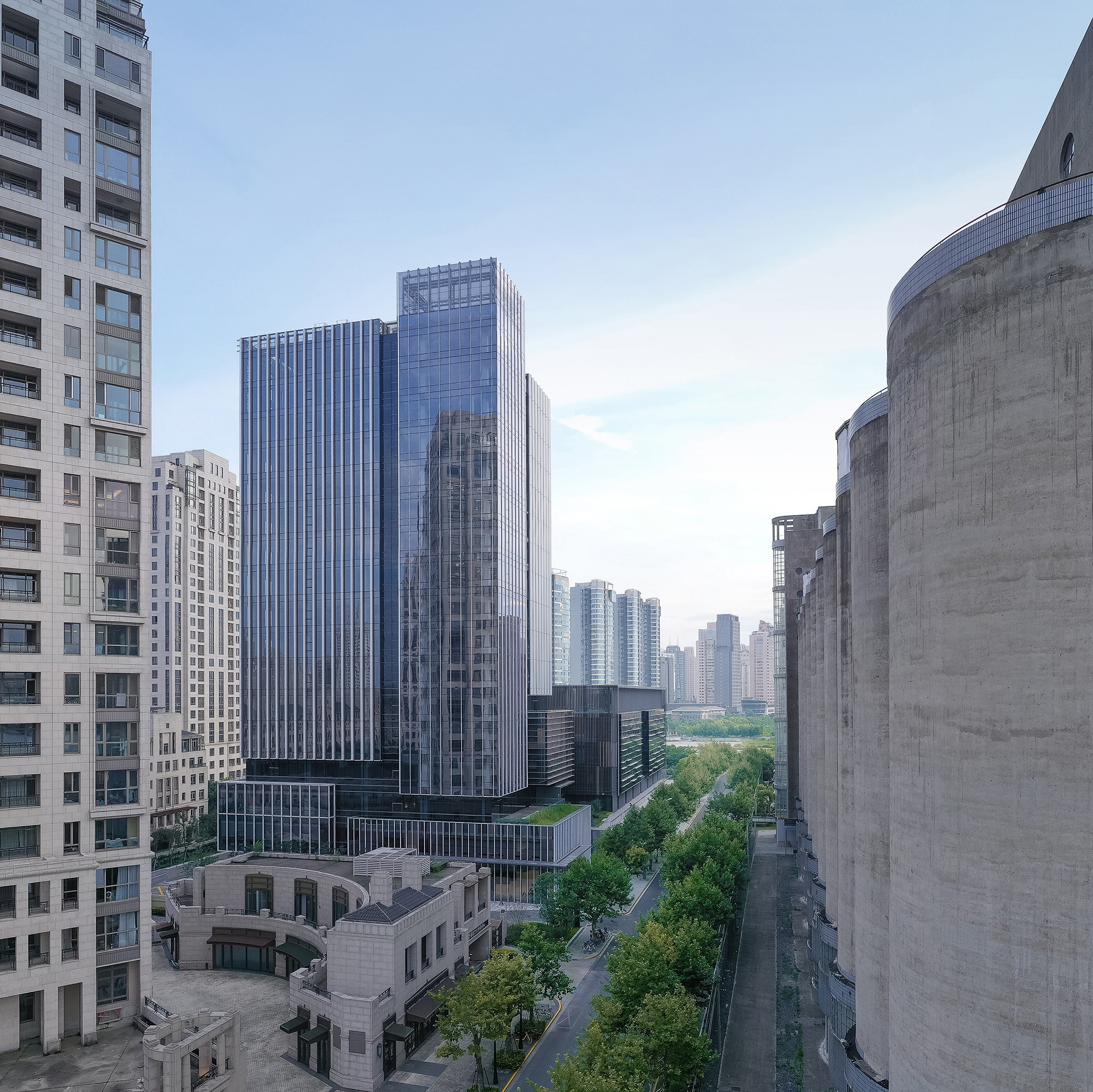

设计单位 EID Arch姜平工作室
项目地点 上海浦东新区
建成时间 2021年7月
办公建筑面积 38,240平方米
引言
作曲家巴赫的复调音乐中,“赋格”是最为复杂而严谨的曲式,贯穿全曲的主要素材被称为“主题”,与主题形成对位关系的被称为“对题”,两者轮替出现在不同声部并彼此呼应,使乐曲达到近臻完美的境地。
在上海浦东民生码头E15-3街区城市更新项目中,面对周边新旧建筑杂糅的城市环境,建筑师以“城市空间的赋格”为介入逻辑,从多角度对位呼应多层面的场地状况与城市空间关系,在浦东滨江路段织补城市肌理,谱写了一段动人的空间乐章。
▲ 项目视频 ©EID Arch
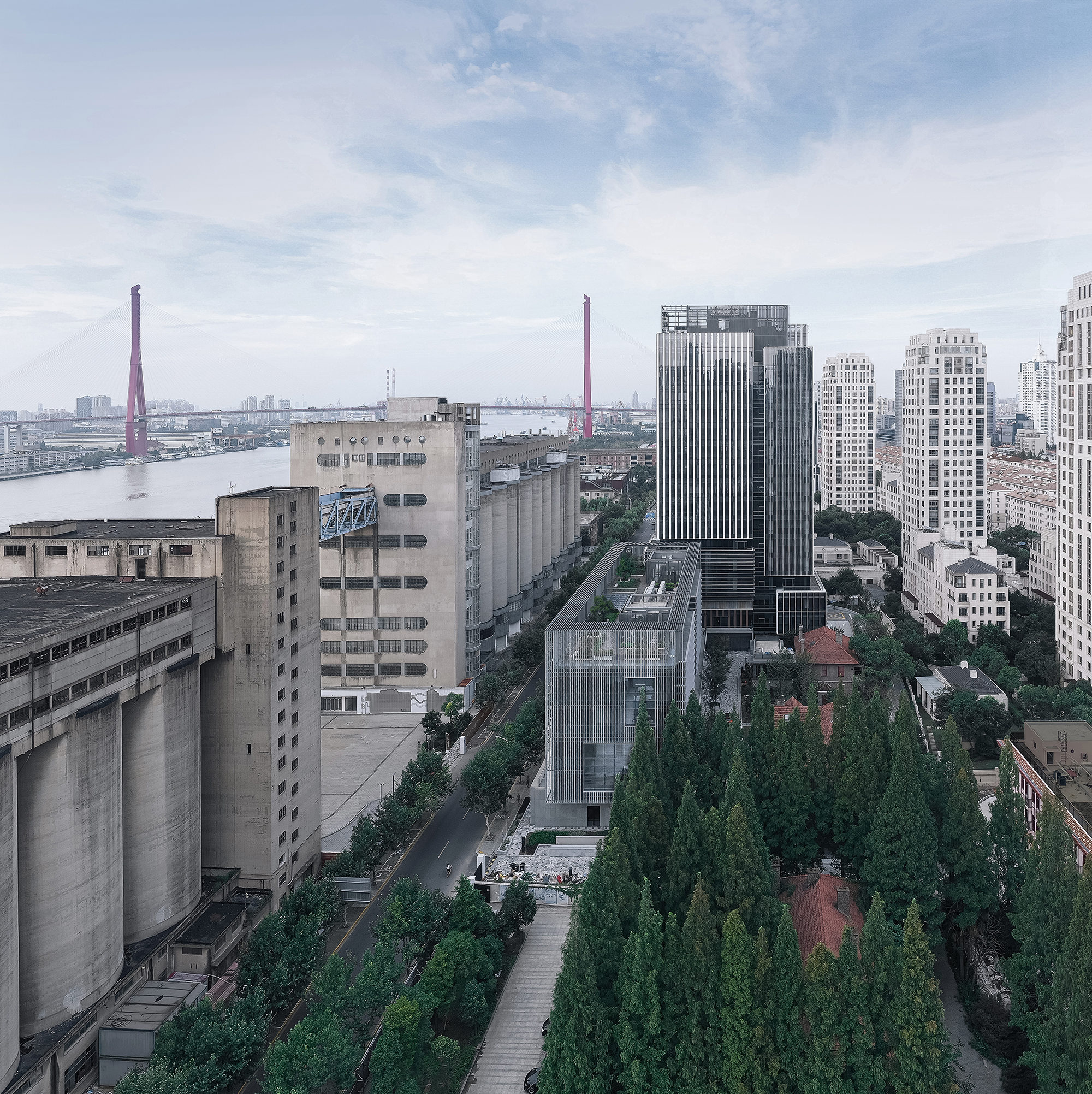
有机更新,新旧缝合的城市肌理
项目基地毗邻浦东民生码头,是被著名工业遗址与历史文保建筑围合起的街区,北起滨江路,南邻规划中幼儿园,西侧毗邻公共绿地,东临美国建筑师罗伯特·斯特恩所设计的新古典主义风格翡翠滨江二期住宅区。
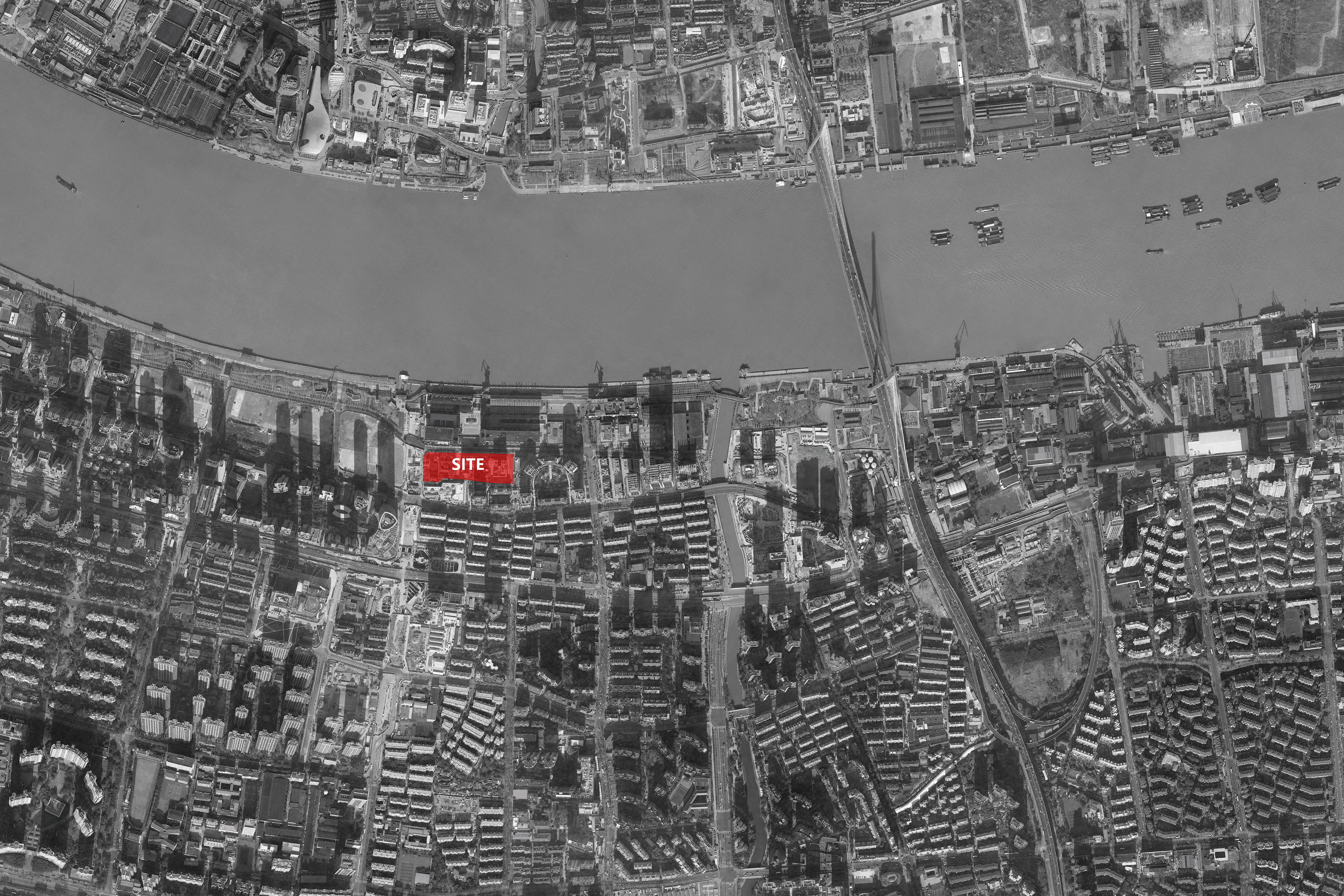
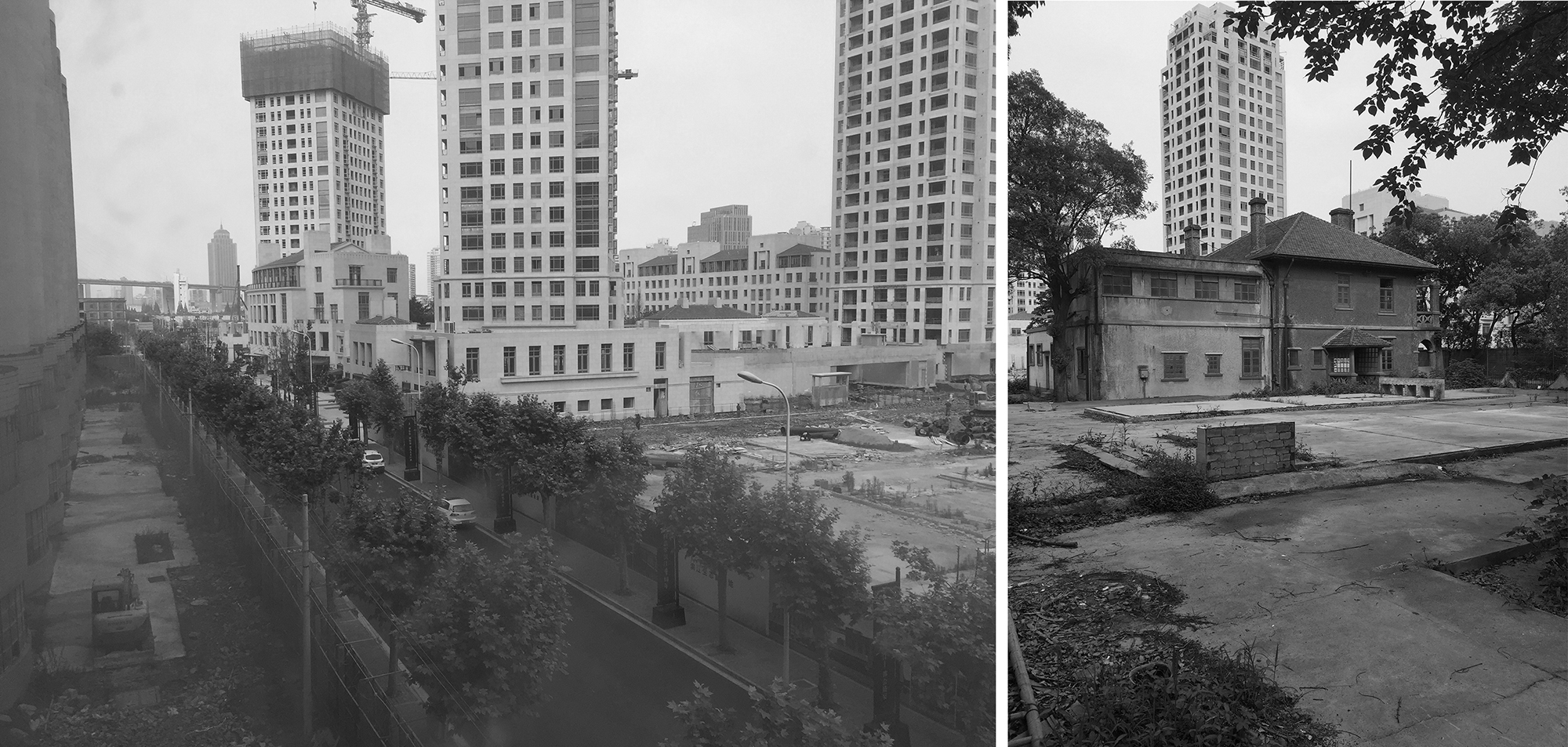
本更新项目历时六年,设计介入的范围包括:新建L形地块中华企业办公及配套、对基地西侧地块老建筑的办公空间改造、历史文保建筑的风貌协调与基地内部街区营造,以及西侧临时建筑文化艺术空间的植入。建筑师从基地环境切入,结合有机更新的理念,通过对周边城市关系的梳理,缝合新旧城市肌理,重构街区空间关系,为浦东民生码头滨江片区的城市空间注入活力。
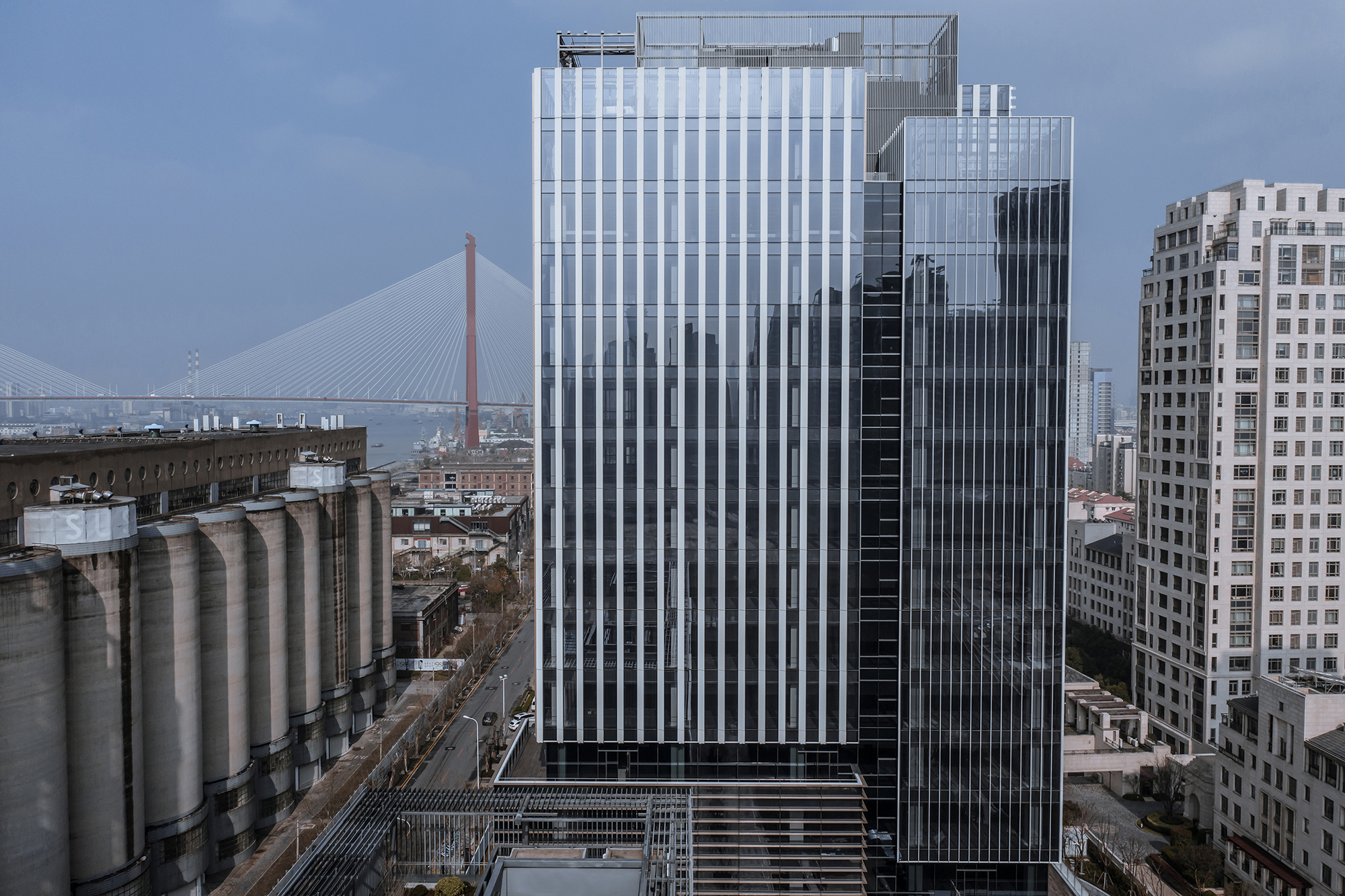
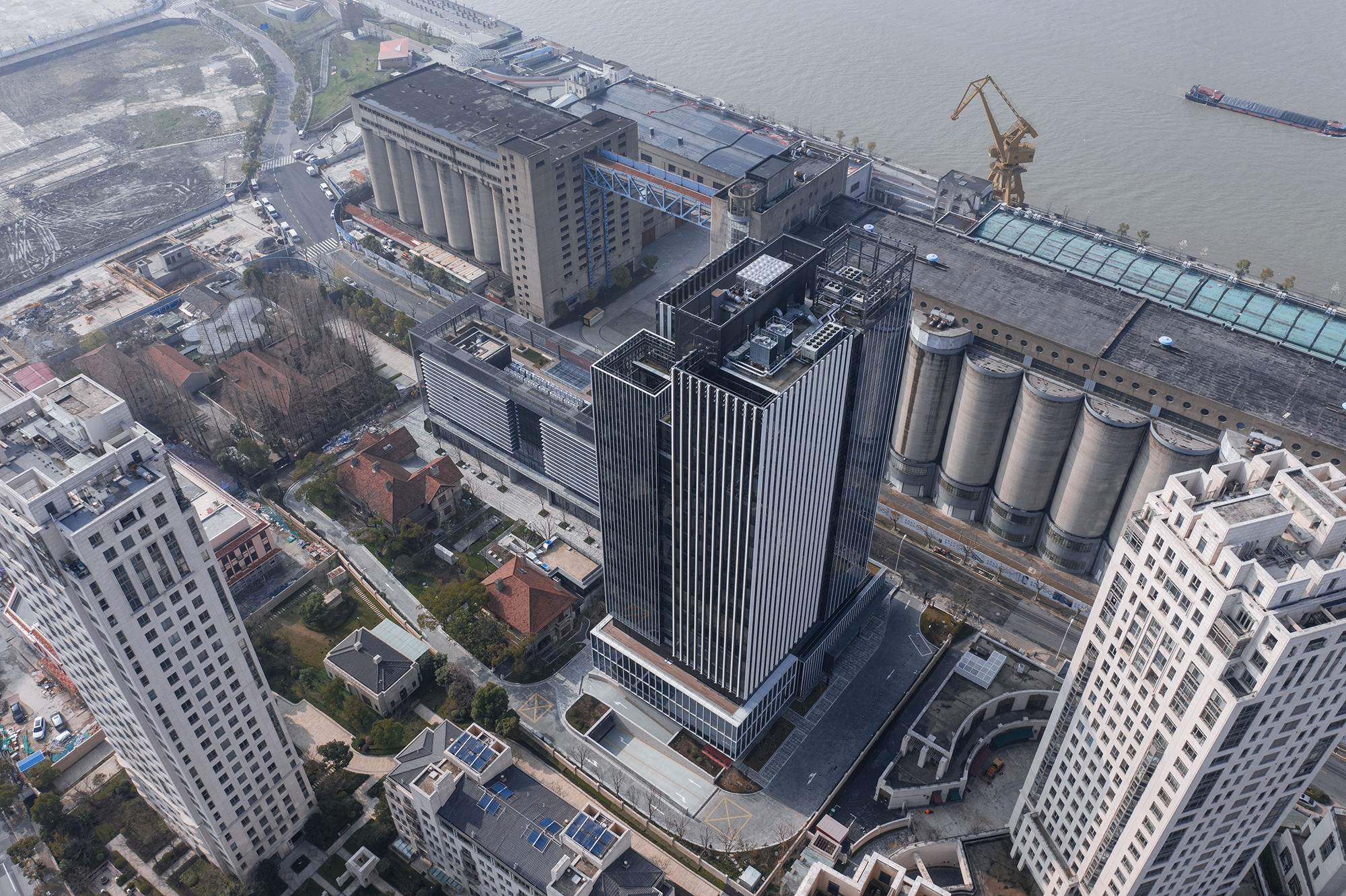

周边建筑与环境难以忽略的强势与矛盾性决定了E15-3项目基地的特殊性,场地周边不同时期、不同风格的建成要素,为基地限定出独特的场域边界。
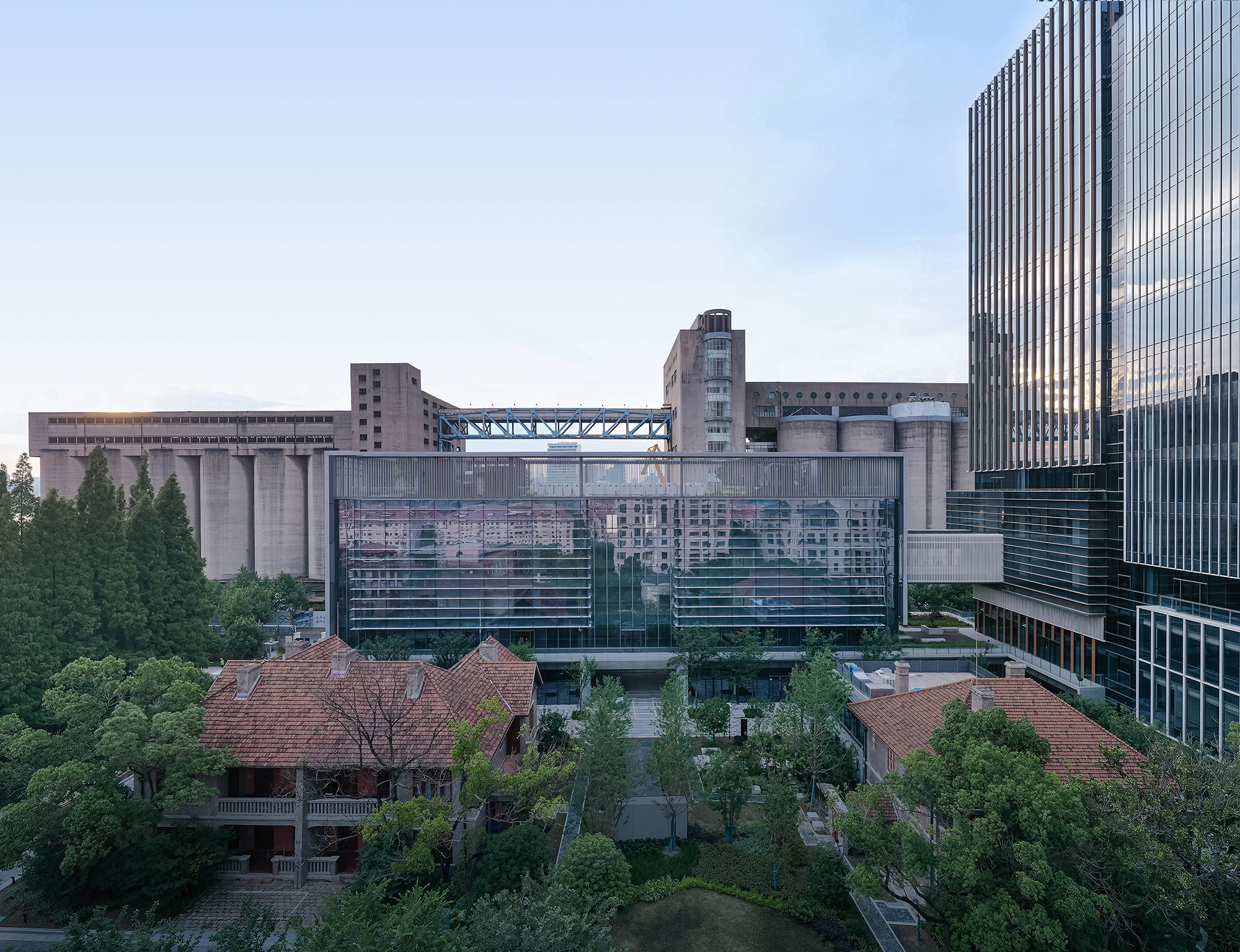
在基地西北侧,是民生码头中极具震撼力的工业遗产——八万吨筒仓改造项目,作为2017年上海城市空间艺术季等重要文化活动的主要展览场地,其巨型混凝土筒仓带有独特的工业历史印记,野性的色彩与形态成为江畔强烈的视觉要素。
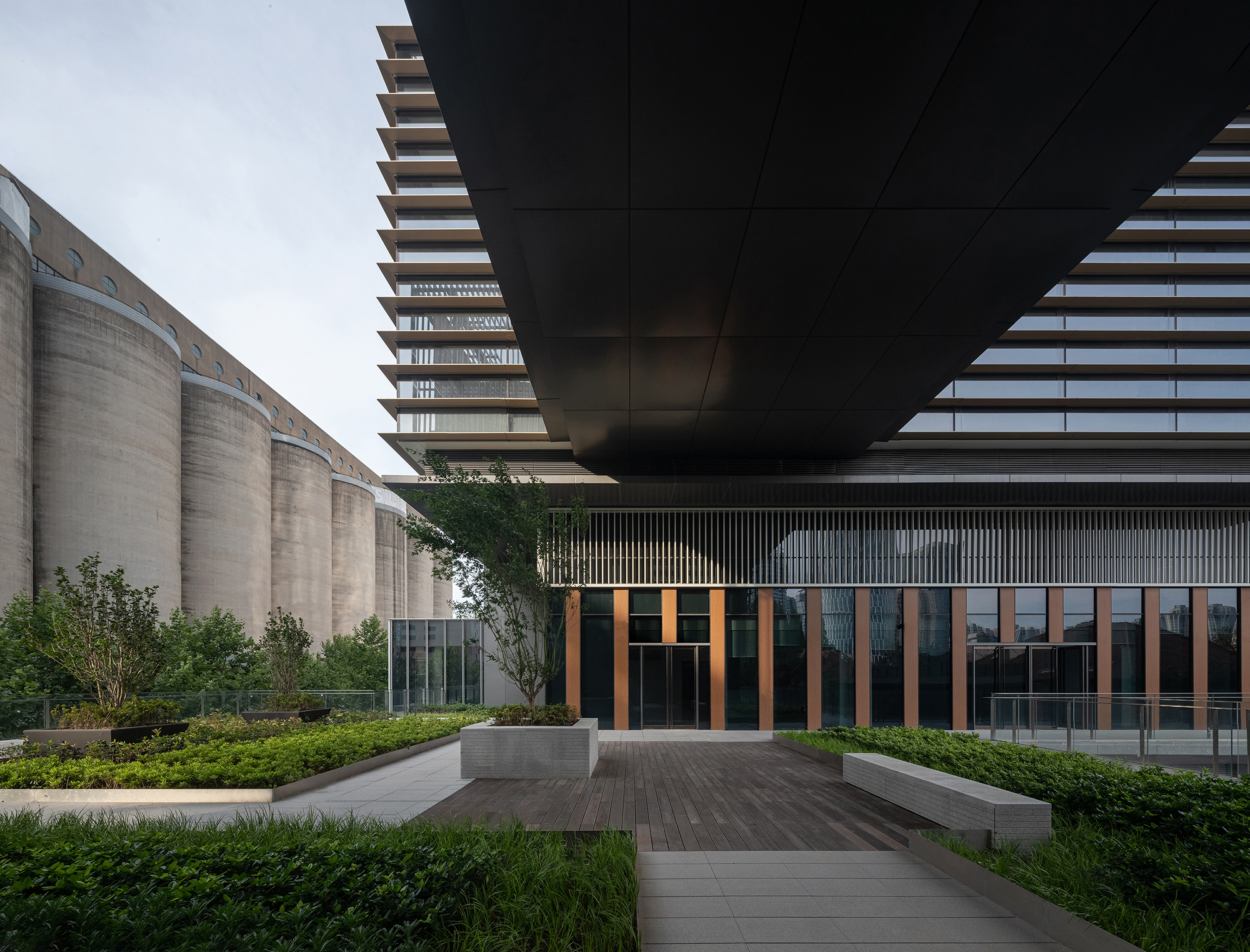
L形地块退让出的空间南侧,是三幢低矮的历史保留建筑,隶属于民生码头,是早年由英商公和洋行设计的德式花园别墅。由于其周边环境的复杂性和历史文脉的特殊性,项目基地是在杂乱无序的城市语境中被“挤压”出的一个城市空隙。
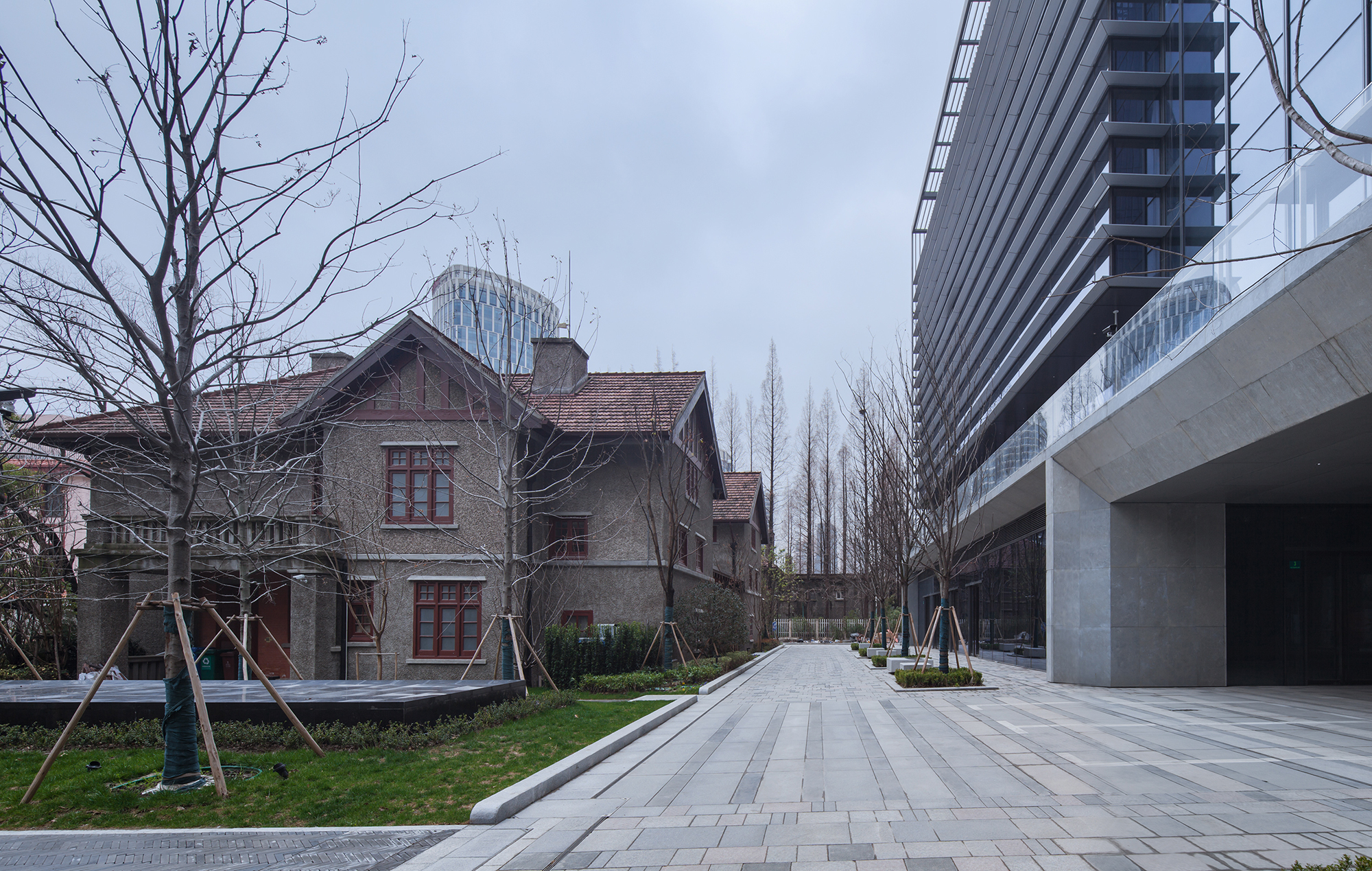

浦东民生码头E15-3街区的建筑设计力图在城市更新改造中创造一组属于城市的建筑群落,它们尺度与类型多元,新旧建筑起伏交融,形成相互呼应的空间复调。
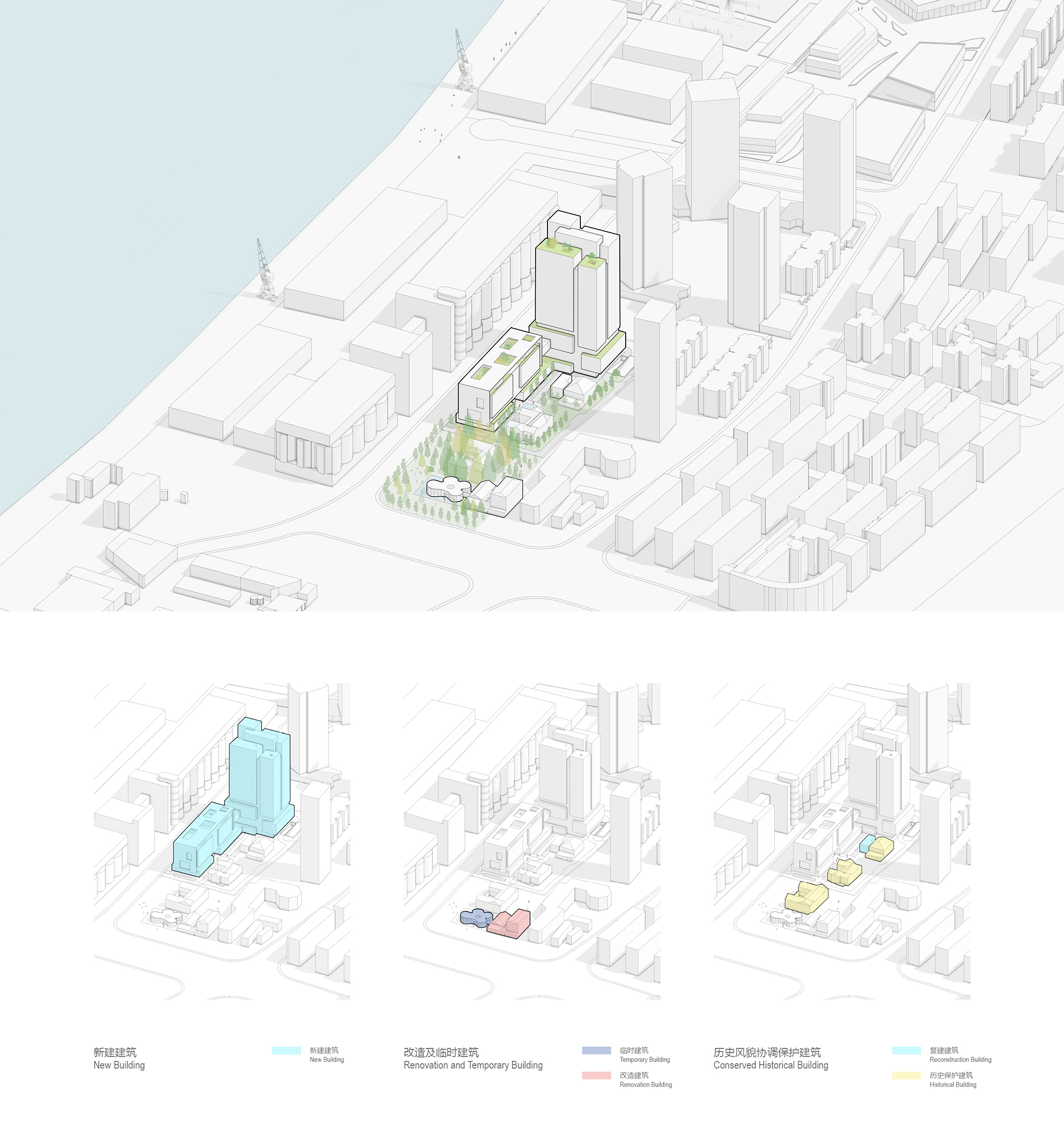
街区重构,多元体验的场所营造
建筑师面临最大的挑战与机遇,是如何在不同年代、不同类型与尺度的建筑群的缝隙间置入新的功能,以重塑街区的城市空间关系,构建舒适人性、绿色健康的公共场所及综合服务环境。同时设计还要逻辑自洽地融入城市语境,以更新的形式激活当地社区,焕发新的城市活力。

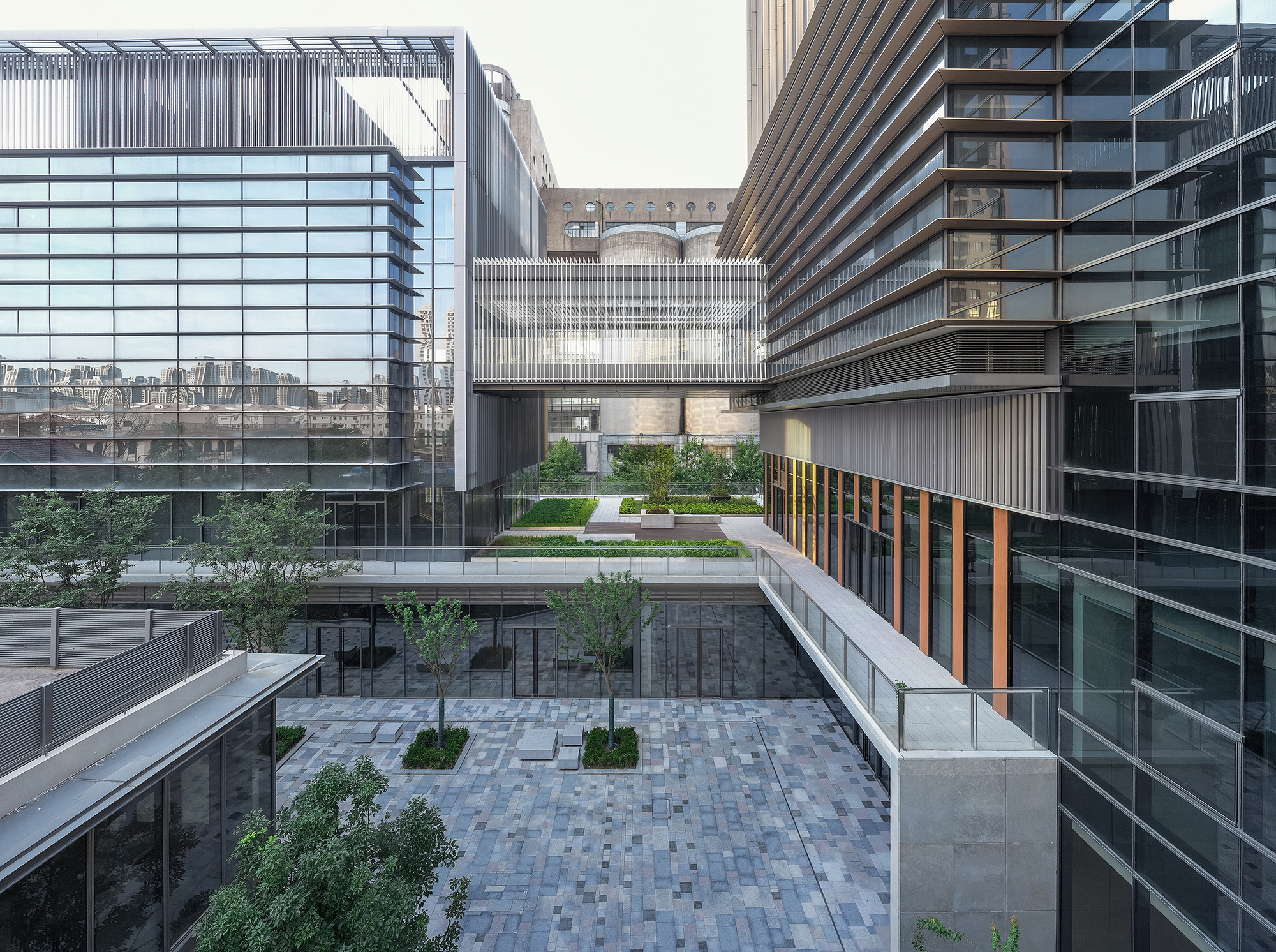
新建的中华企业办公项目同时面向城市与内部街区,是本城市更新项目的设计核心。项目占地面积约9640平方米,建筑面积约四万平方米,以建造陆家嘴黄浦江沿岸独特的办公工作场所及配套服务为目标。
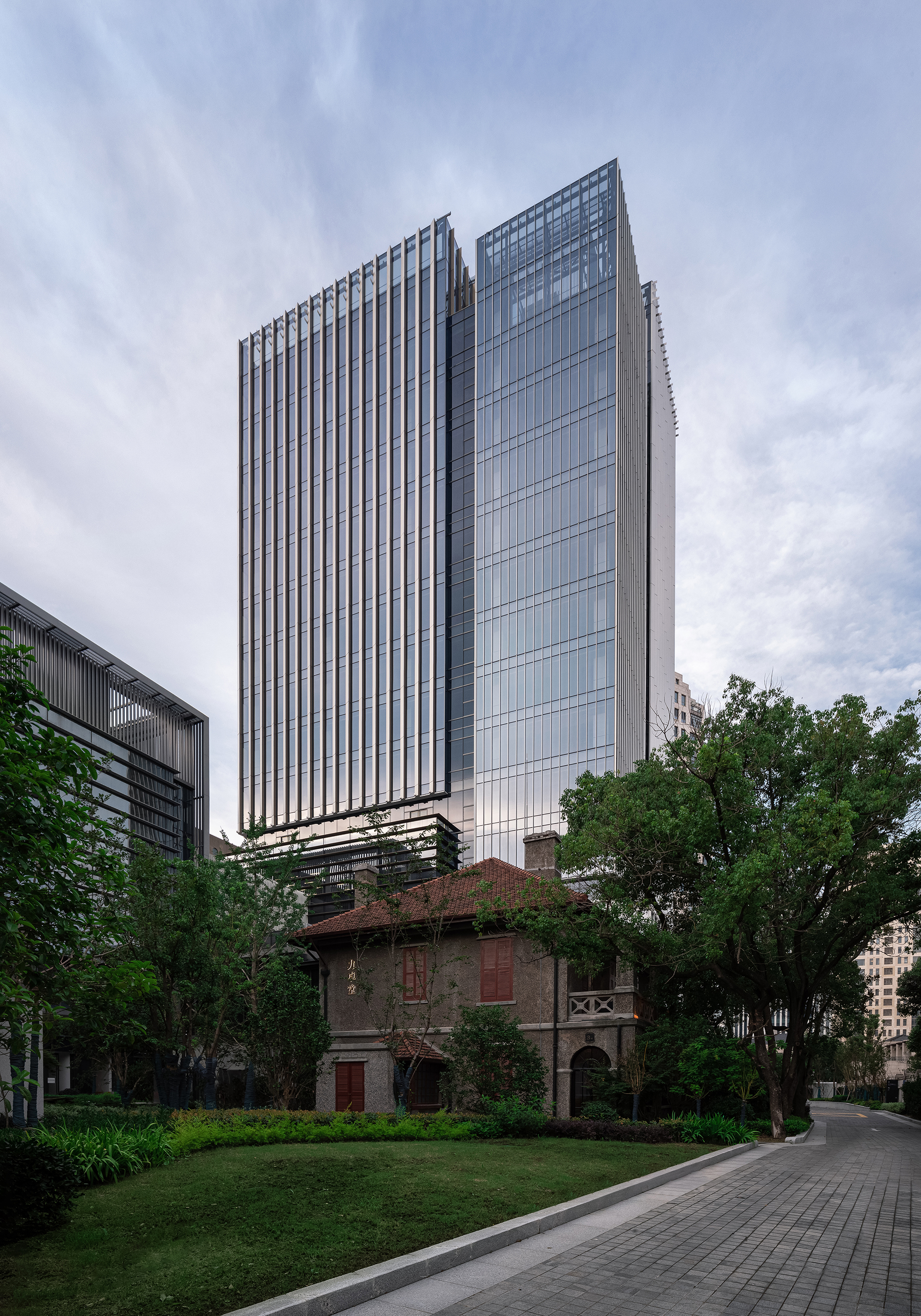

在整体设计策略上,塔楼拉高整体高度,减小标准层的面积,并偏心设置核心筒,以争取最优的景观条件,在建筑高区得以俯瞰整个黄浦江景;部分办公空间以顺极而流的形态,被延续折叠成亲切宜人低层的体量,楔入场地中,以此呼应南侧低矮的文保建筑群,并作为内部界面与周边建筑共同打造新的街区,塑造城市空间新旧肌理融合交织的新格局。
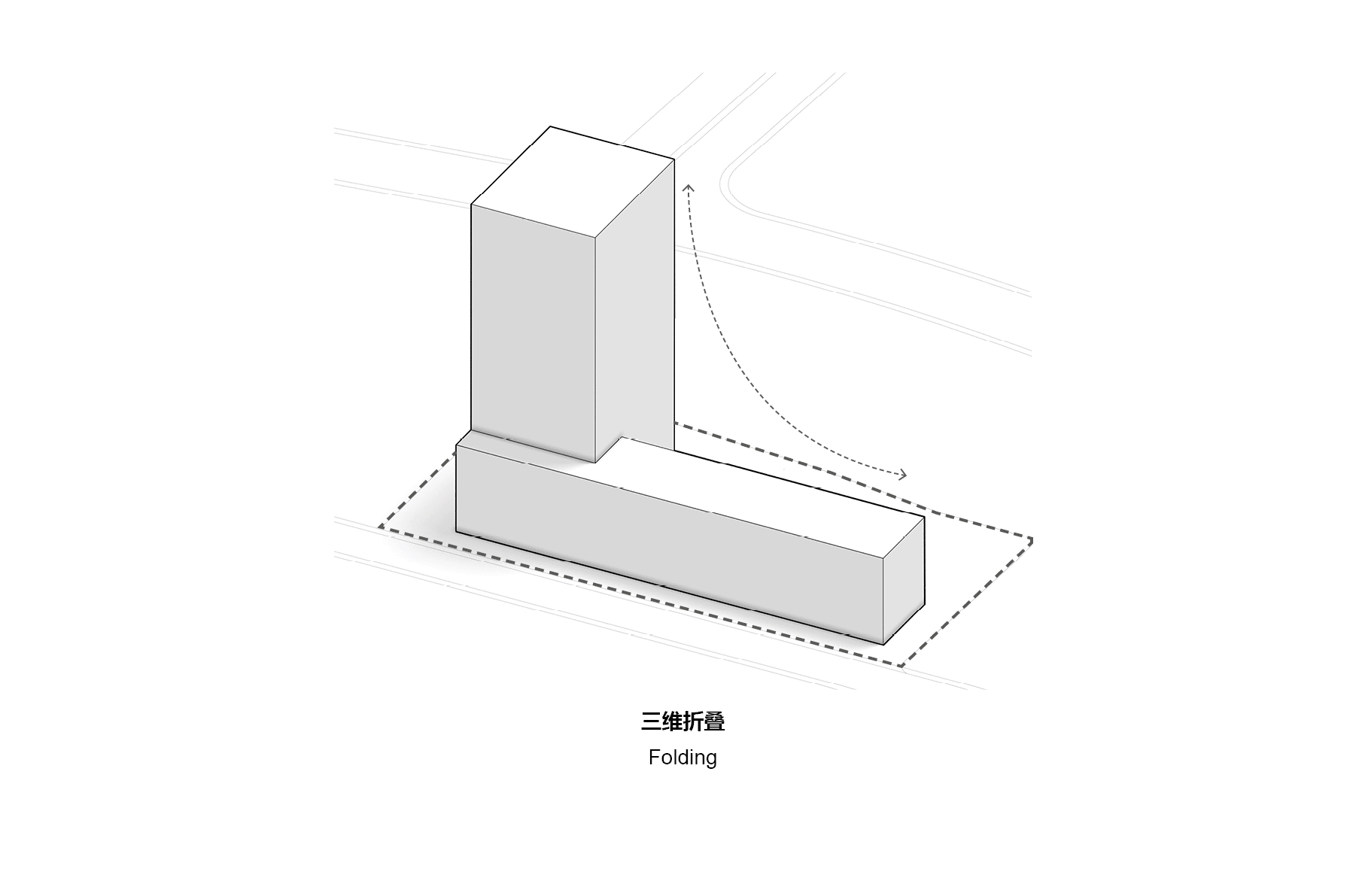

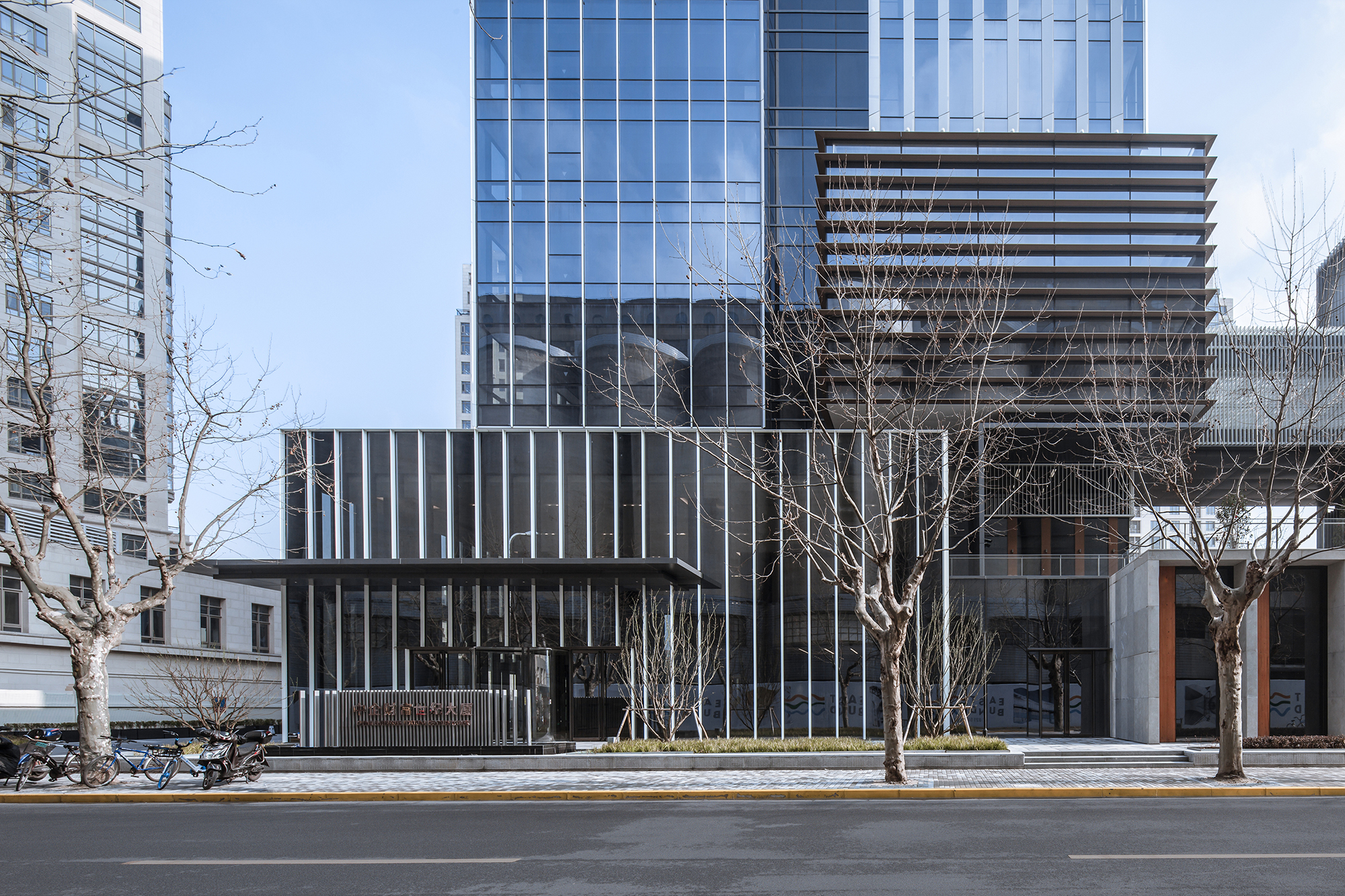

时空加叠,消解与对位的空间回应
项目的设计初衷并不在于突出展现一个吸睛的建筑奇观,而恰恰相反,它更想以内敛沉静的方式平实叙事,讲述一个城市时空加叠与新旧融合的故事,谱写新的城市空间赋格。
在设计手法上,“消解”与“对位”成为关键词。即便在高层办公空间,一个完整敦实的矩形体块也会让人在视觉上感到压迫。设计团队采用“化整为零”的手法,将整体化解为四个竖向起伏相契的玻璃盒子,既保证了功能空间的统一,又在立面韵律上与周边筒仓工业遗址产生时空的对话——有关新与旧、有关历史与现代、有关保护与传承。
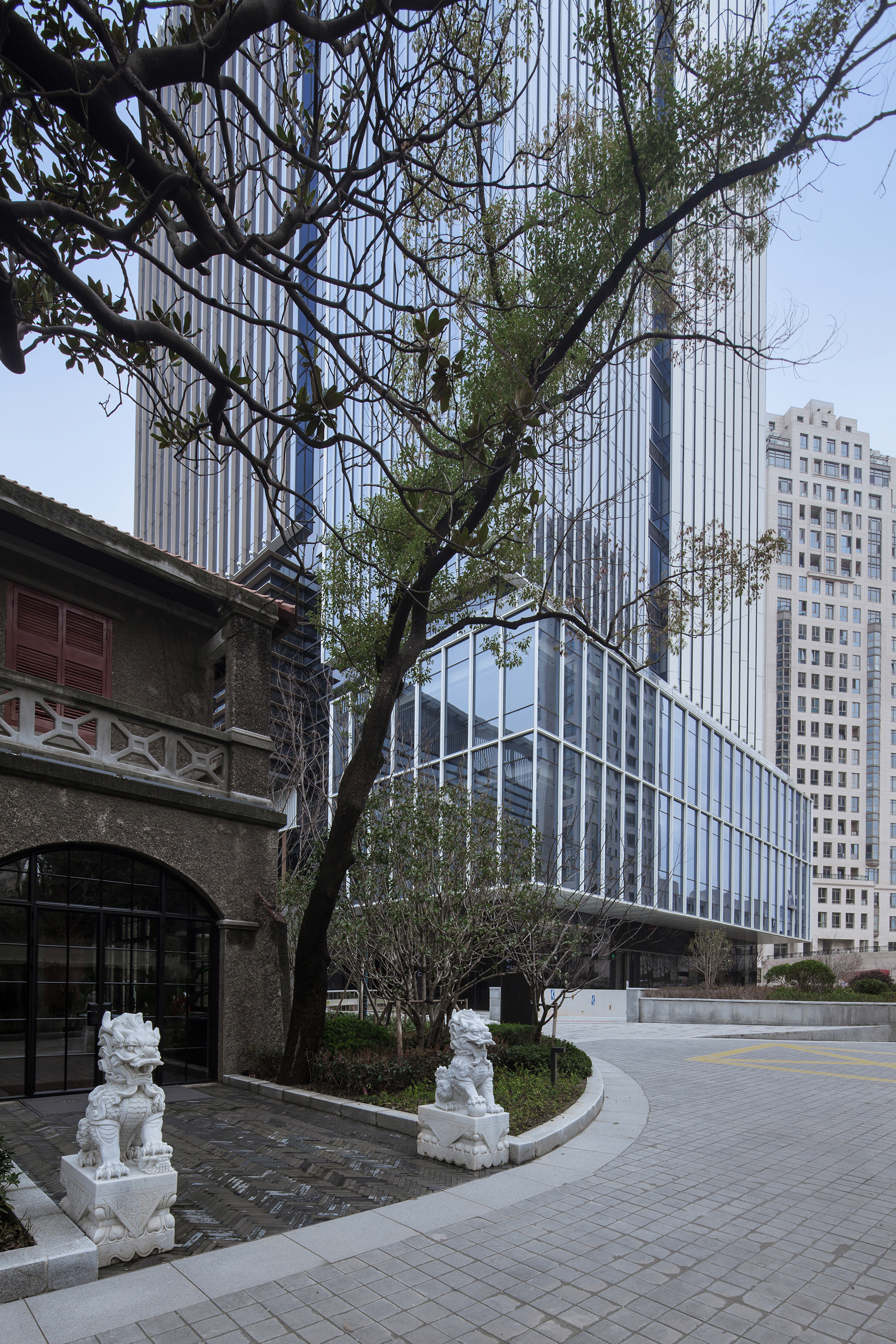
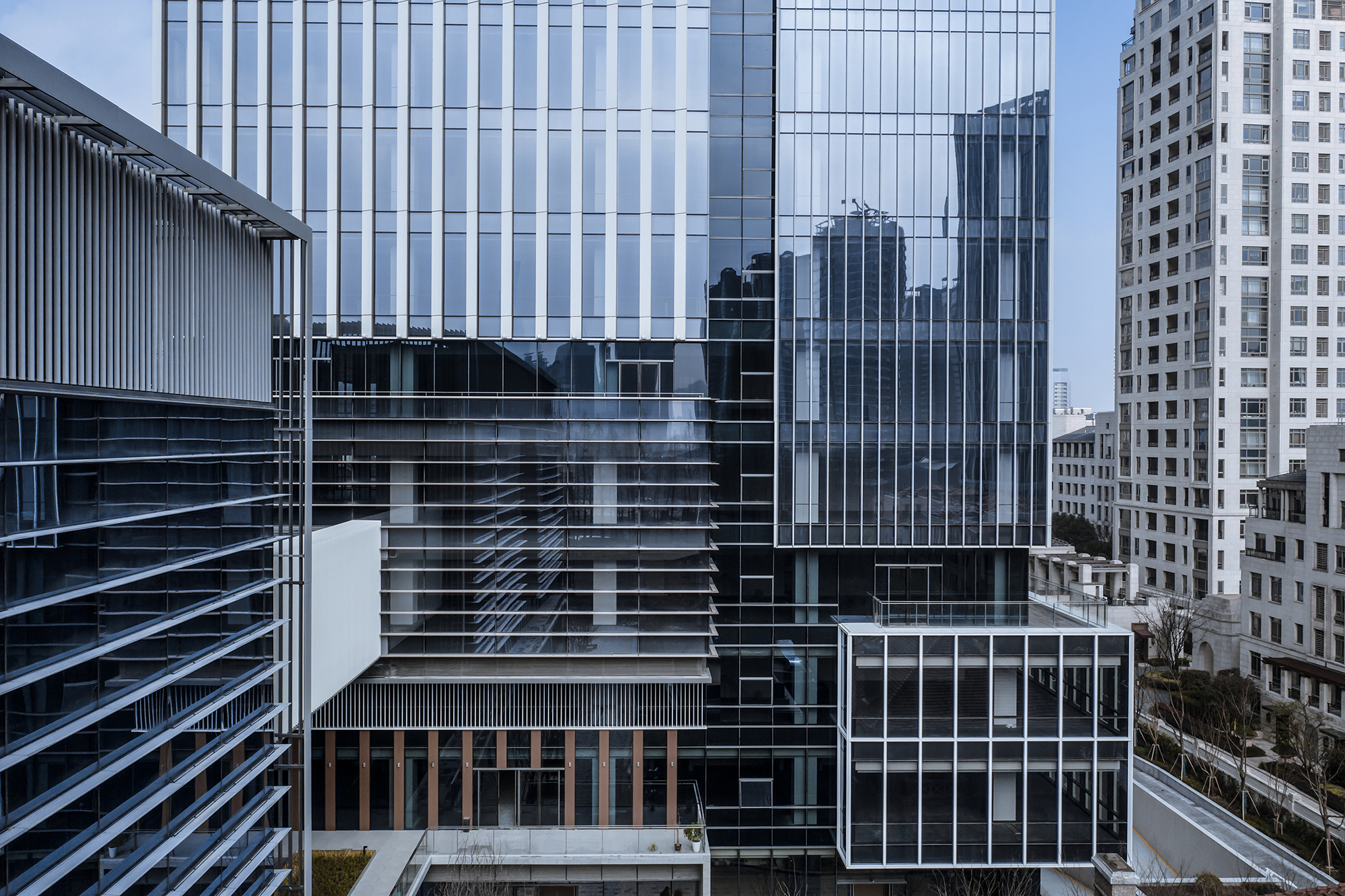
塔楼和裙楼之间以较纤细的横向通廊相连接,除了满足建筑本体内交通的便捷性,在更大图景上是对西北侧体量韵律感极强的筒仓项目起到了“对话”与“破题”的作用——“空间赋格”设计逻辑的核心也在此得以体现:跃动起伏的变化中保持格调一致,简约体量的设计中以细节呼应。建筑师对该更新项目的思考不仅仅停留在项目本体的设计,更关照到整体周边环境,在意“新生”的空间对城市生活的意义。
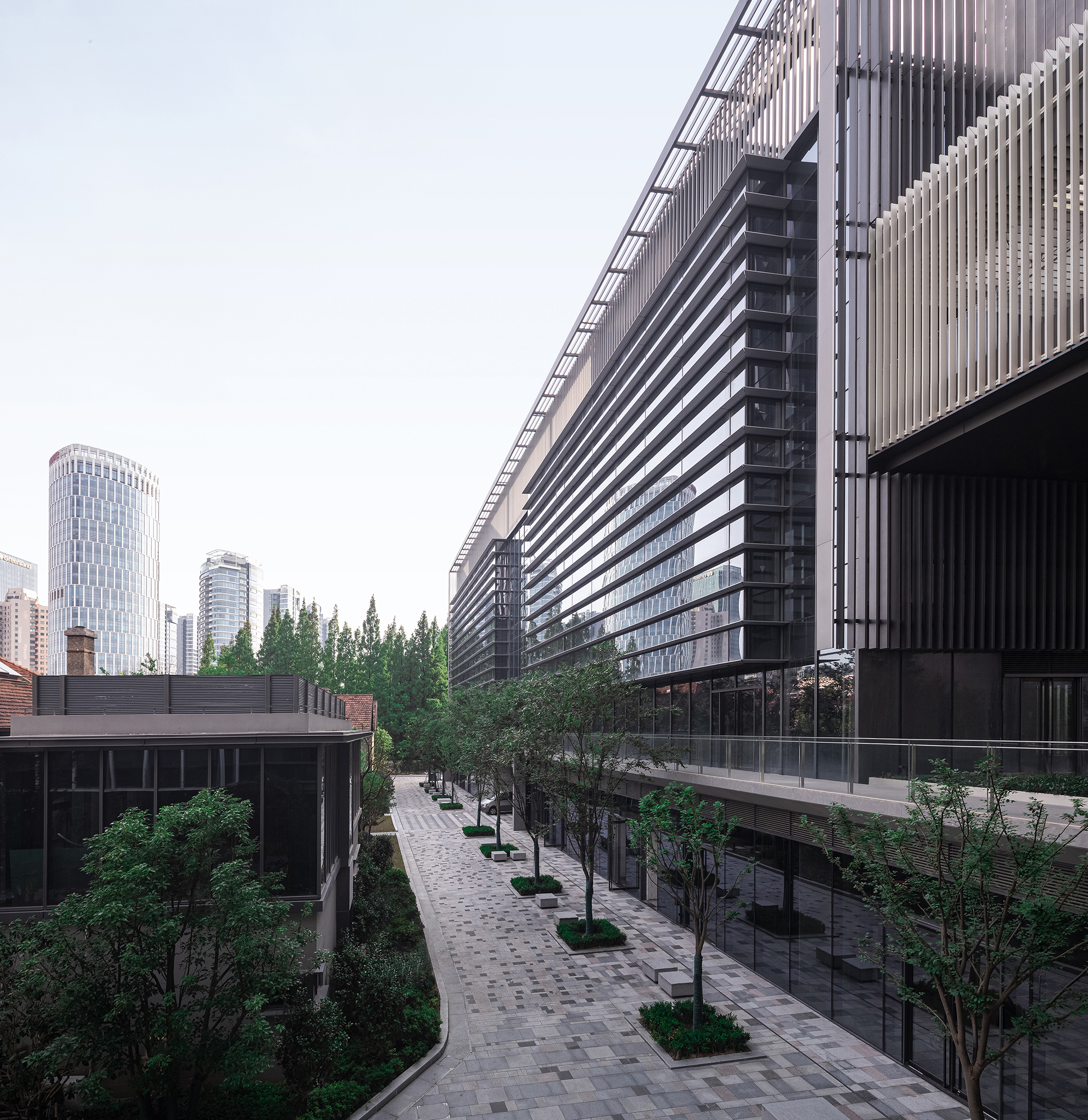
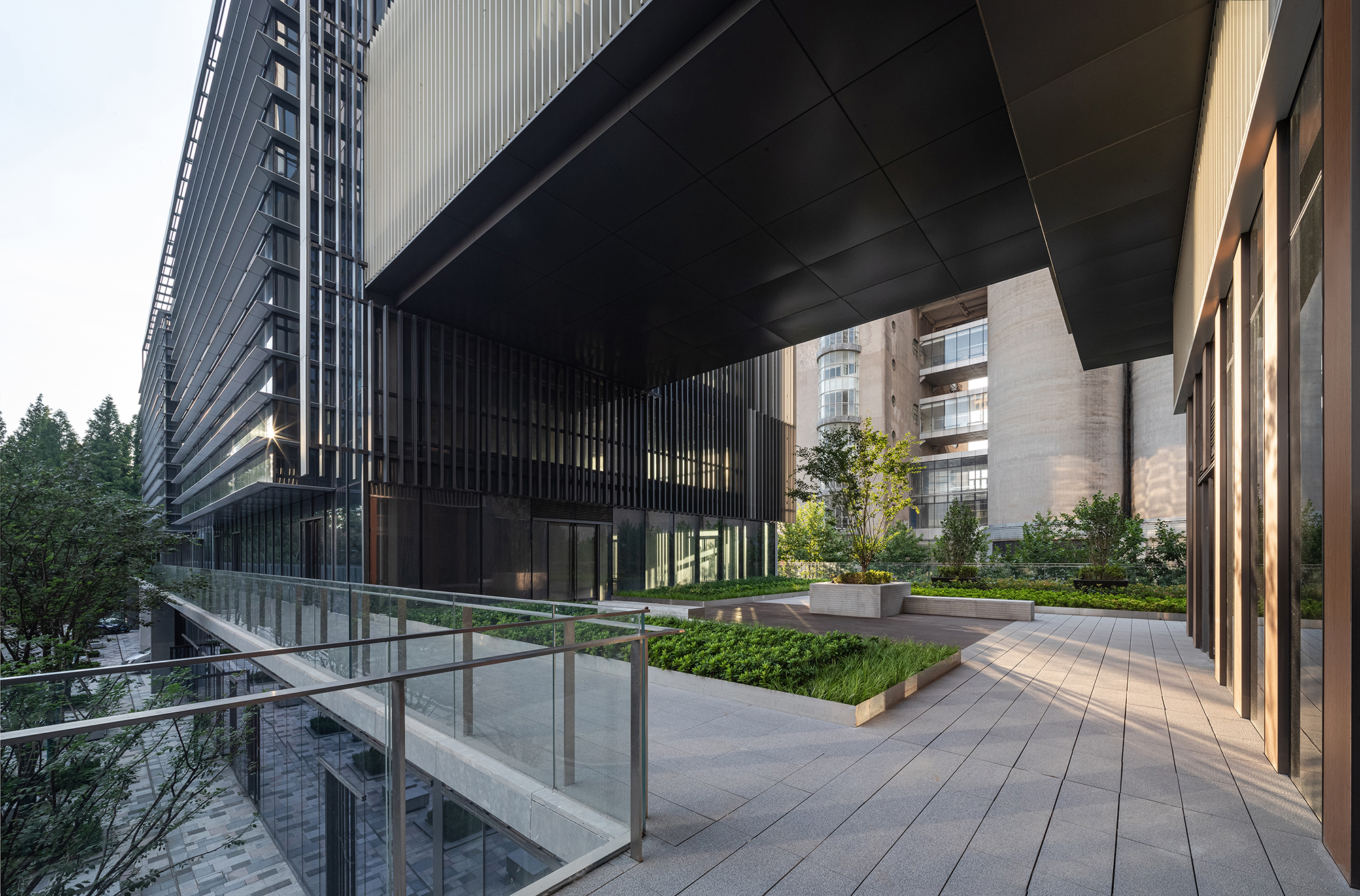
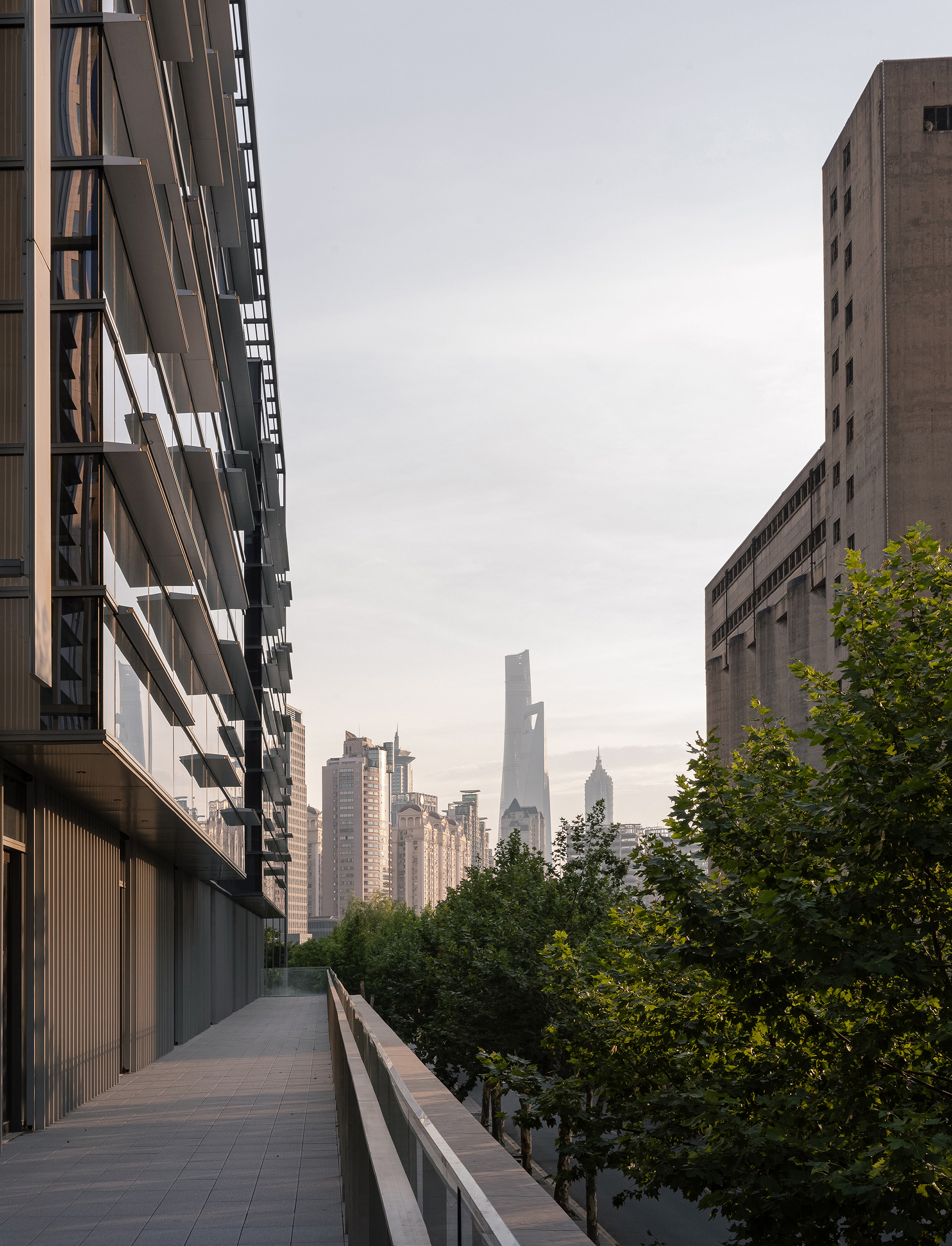
建筑中的对位关系和传统园林中框景的手法也被巧妙应用在项目中。塔楼四个竖向的空间体量与筒仓的体态相呼应、东高西低的高度变化与周边建筑的体量相呼应、建筑立面横纵栅格清晰的几何划分与工业旧址氤氲的气氛相呼应。
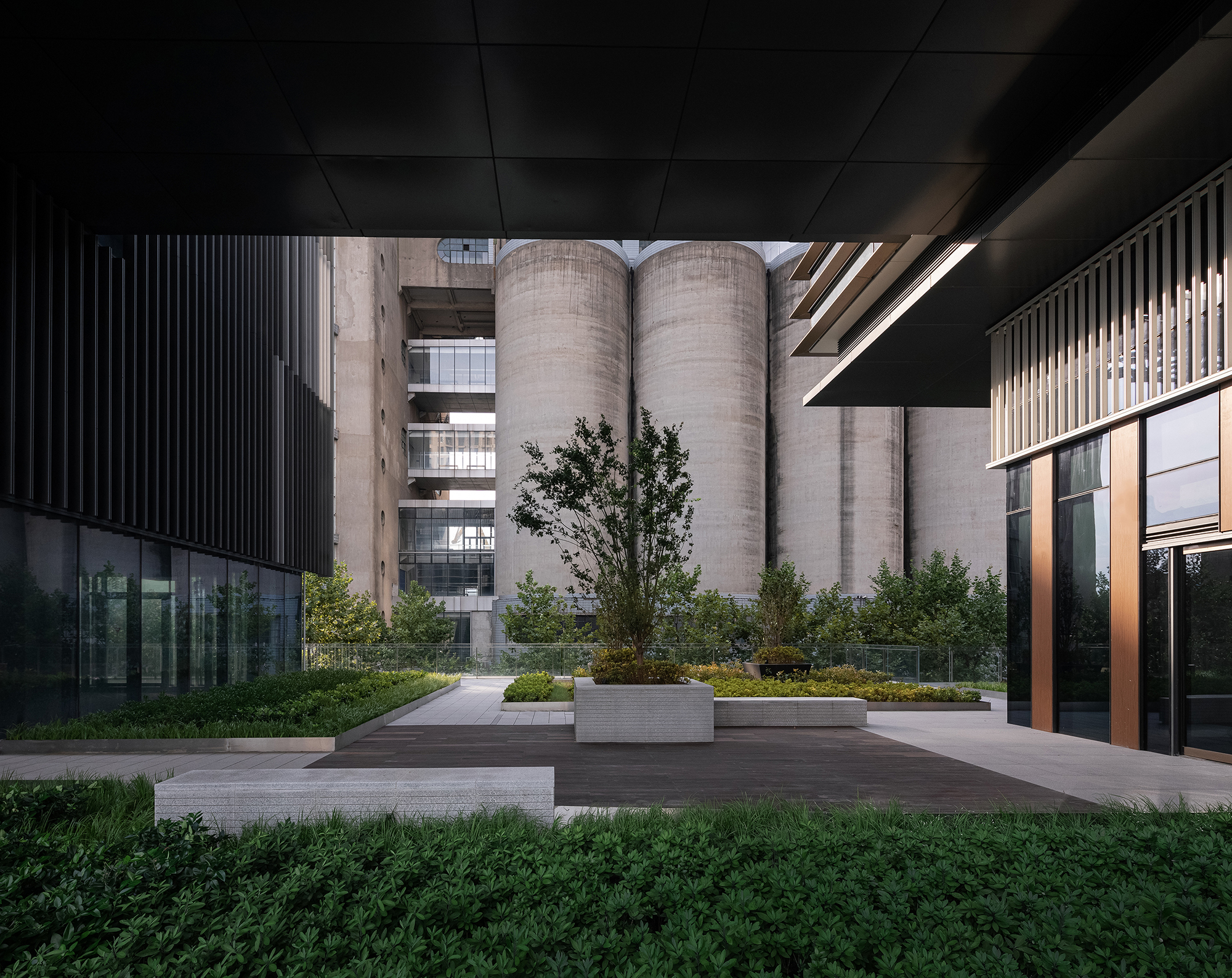
塔楼滨江一侧设有多个竖向叠加的共享中庭,户外在不同高度设有一系列景观露台,为办公用户提供室内外交流互动的场所,形成多维的景观系统。在新建筑的罅隙间,不经意地一瞥就可以看见如取景框般对周边景观的精准抓取,两者互为风景。
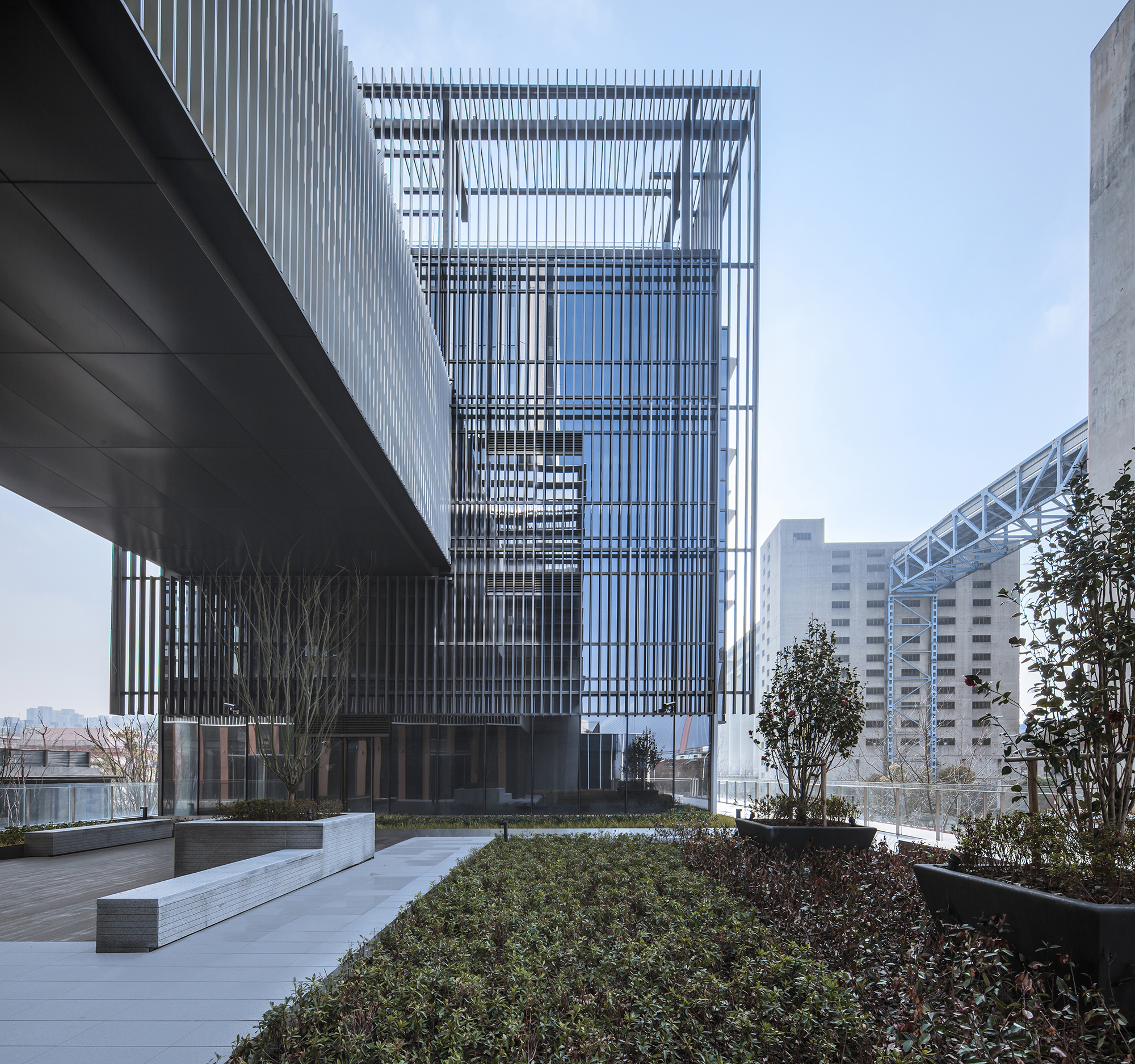

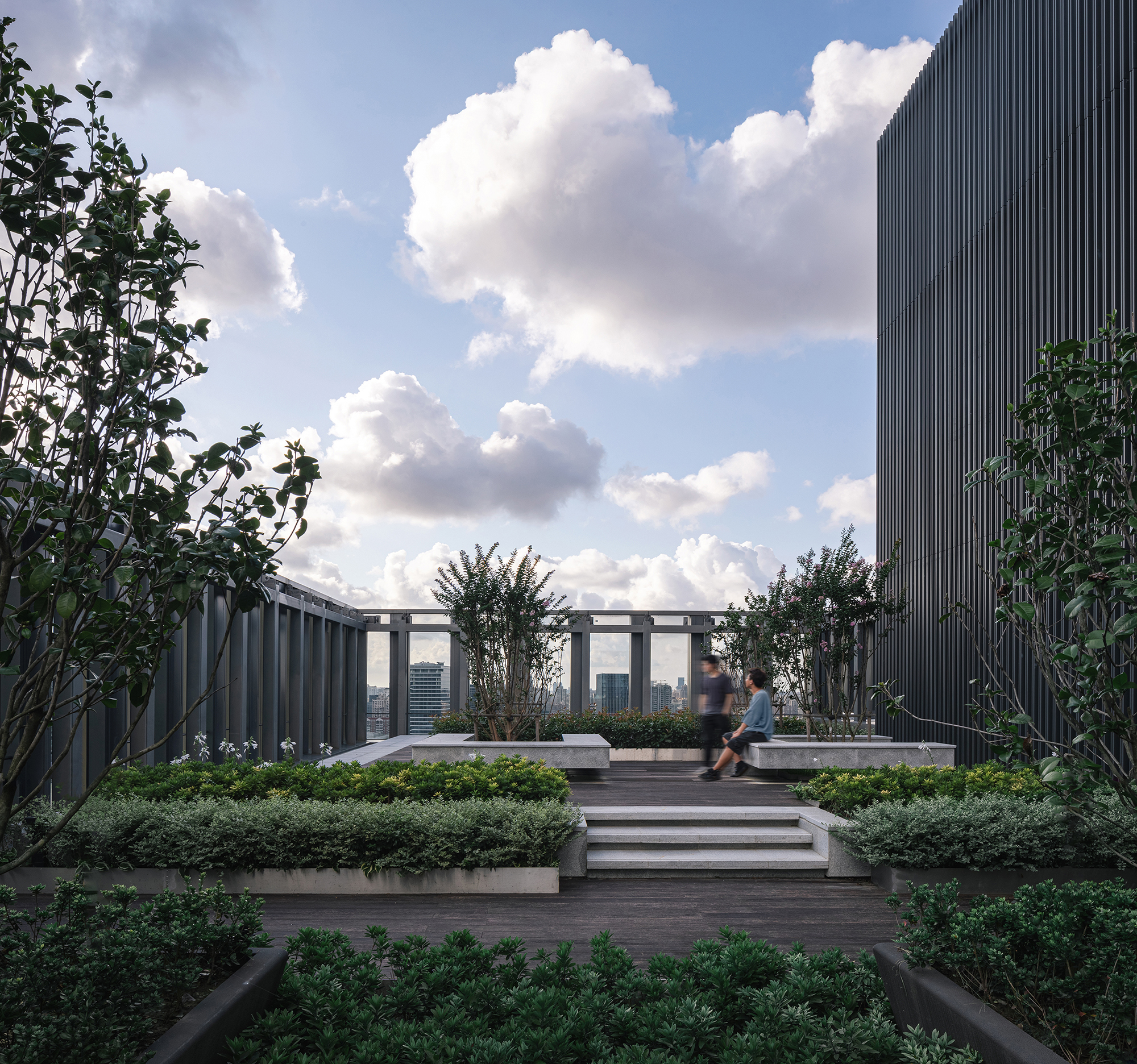
城市风景下的建构细部
与传统办公建筑不同,项目在城市界面选择摩洛哥灰的石灰岩,以喑哑低调的灰色基调与筒仓的混凝土材质相应,塔楼上的竖向及横向线条细节材质呈金属铜及原木等的暖色调,在空间色彩性格上很好地与周边历史建筑氛围氤氲相融。同时,在横向通廊及面向筒仓的公共平台的立面格栅等细部中,设计采用了工业建筑元素,既具有精细的肌理和自然的质感,同时延续了民生码头场所精神,赋予建筑更多可读性。
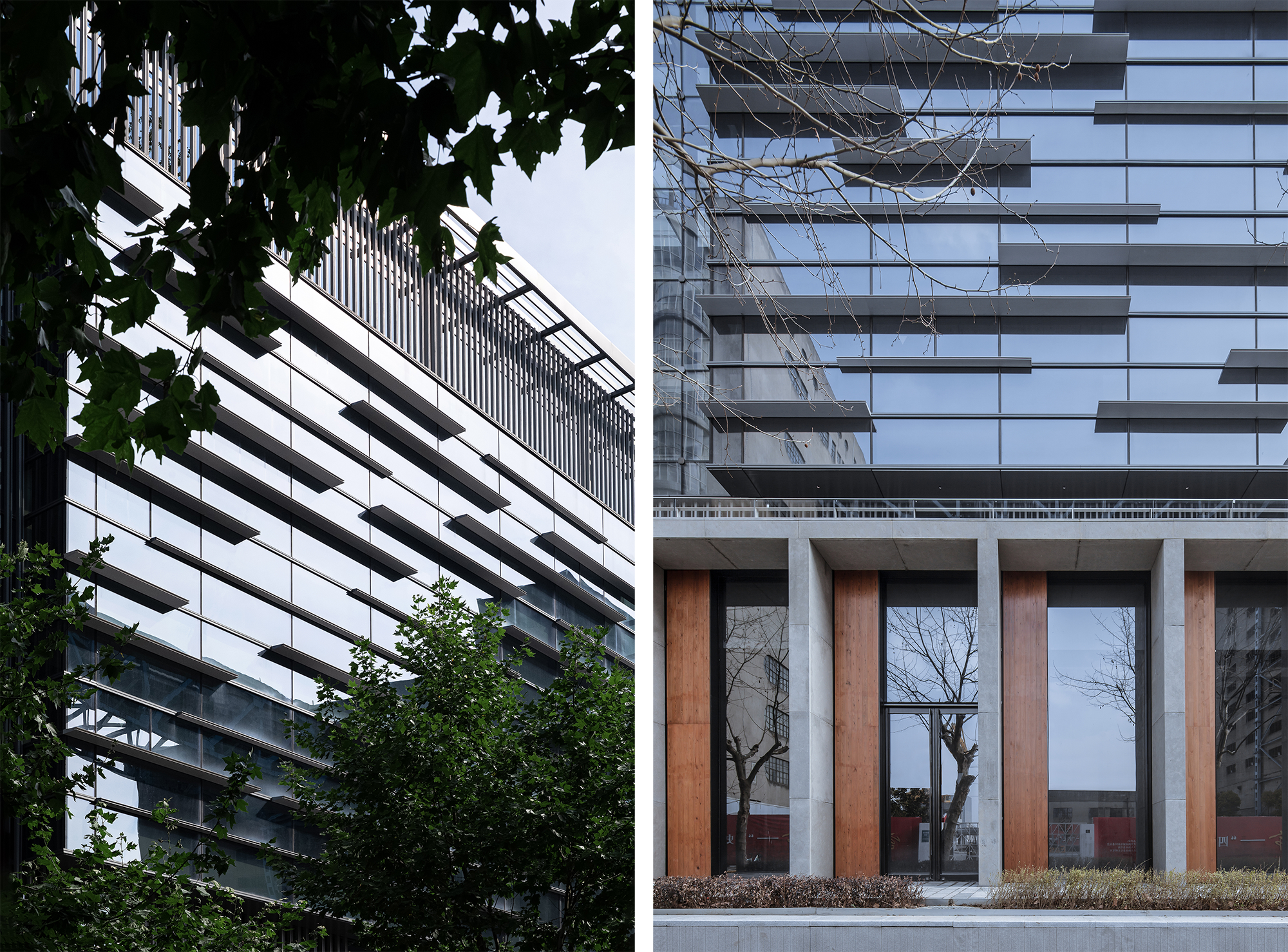

幕墙之上的实体部分根据周边建筑肌理和形态,设计优化了四个竖向体量各立面的设计模数,通过竖向节奏的变换形成不同韵律,在比例上呼应周边形态风格各异的建筑群。根据朝向,建筑师进一步调整幕墙杆件尺寸,以平衡室内光线亮度,柔和采光。

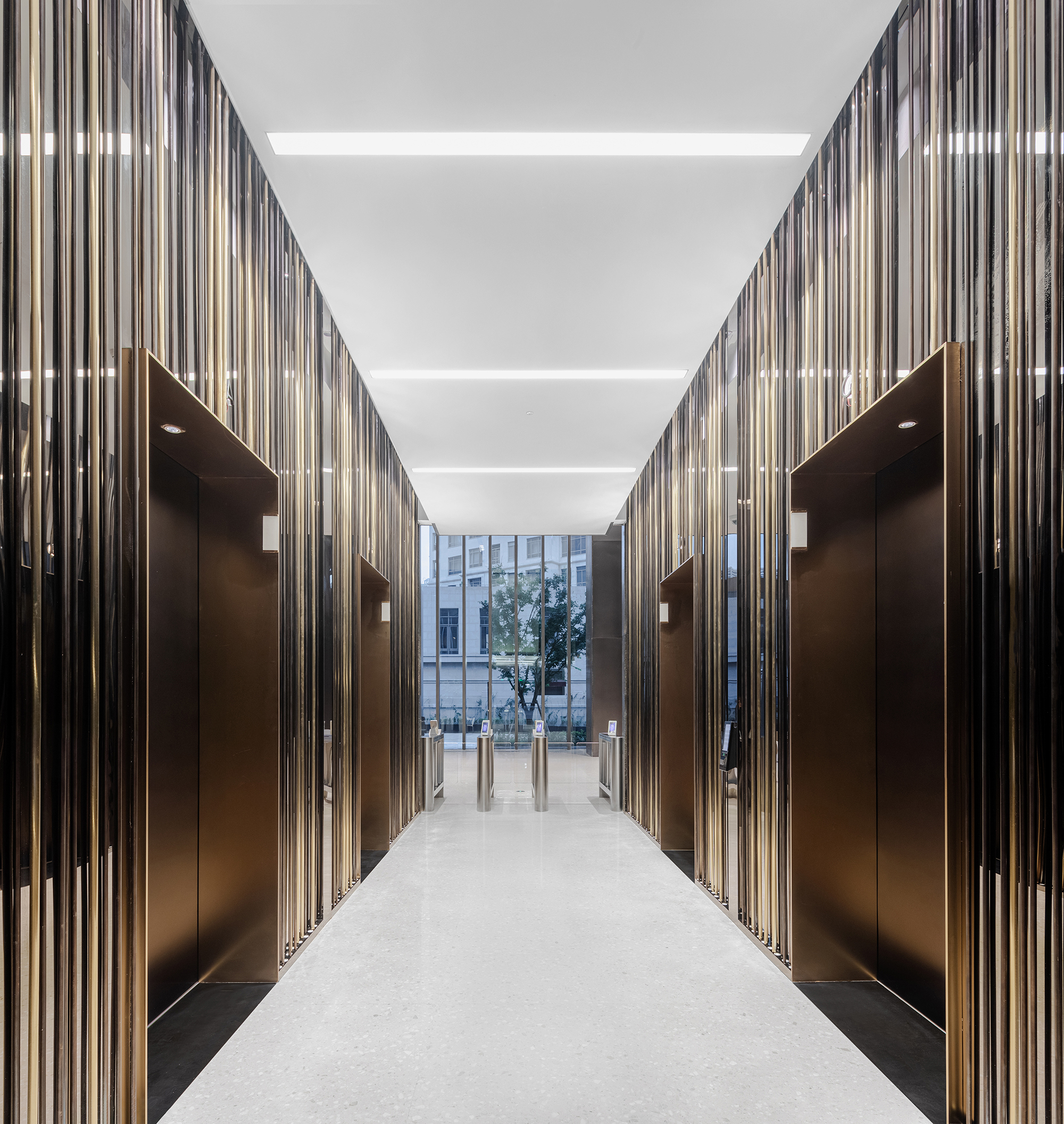
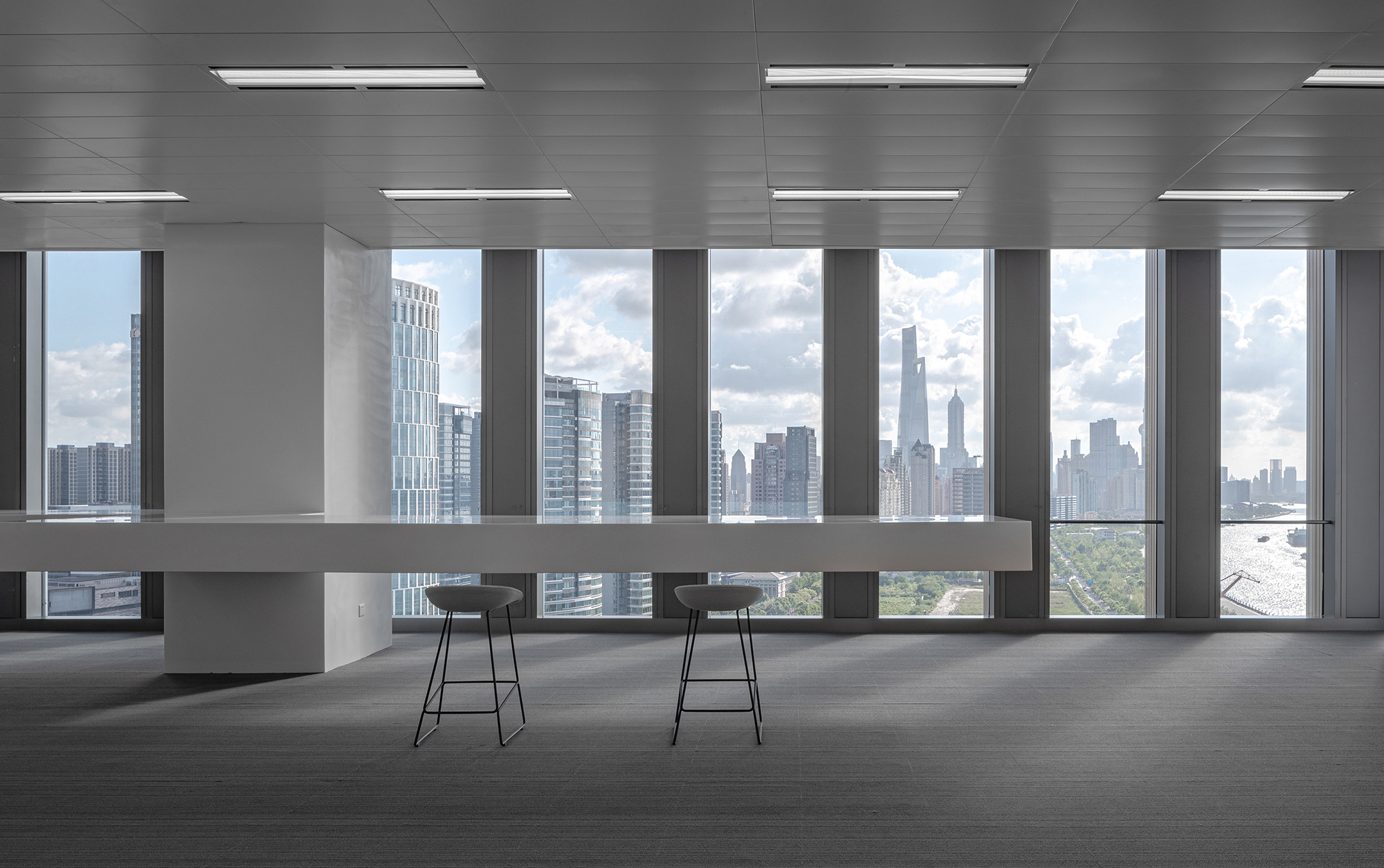
同时,面向住宅的部分采用7%反射率的节能LOW-E玻璃,防止光污染,降低对环境的影响。当四周建筑映射在塔楼的抽象体量上,疏密有致的分割构件随时间行进,成为一组光影变奏曲,时间、城市与建筑建立起更感性的联系。
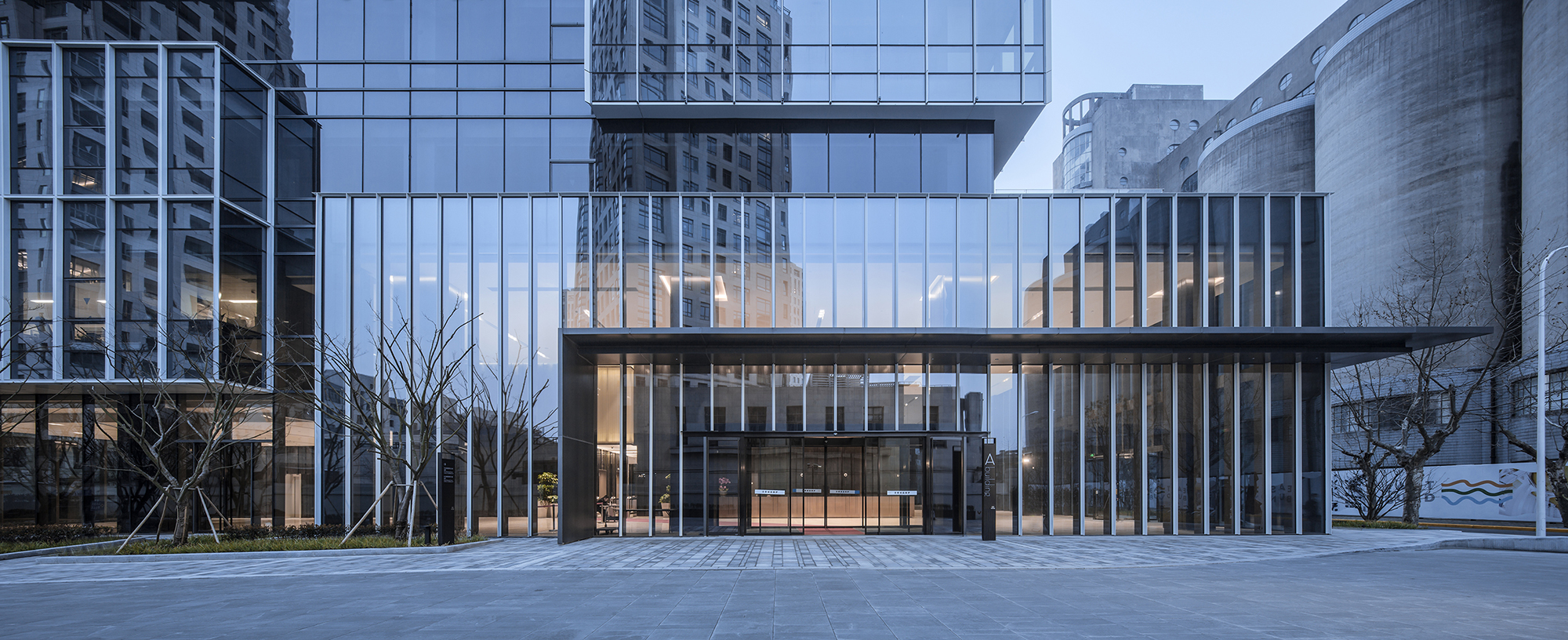
结语
上海浦东民生码头E15-3街区城市更新项目在完成建筑本身功能需求的同时,不但有力回应了城市抛出的问题,完善肌理脉络与结构,并作为植入的新空间激活了旧有环境。它们以织补的手法完善城市空间结构,以空间赋格的曲式逻辑对位城市周边环境,以“针灸式”的细腻姿态温和介入整体场域中,在滨江沿岸串联出全新的办公商务空间、旧改建筑和临时文化展陈空间,为城市生活带来更深层次的价值提升。
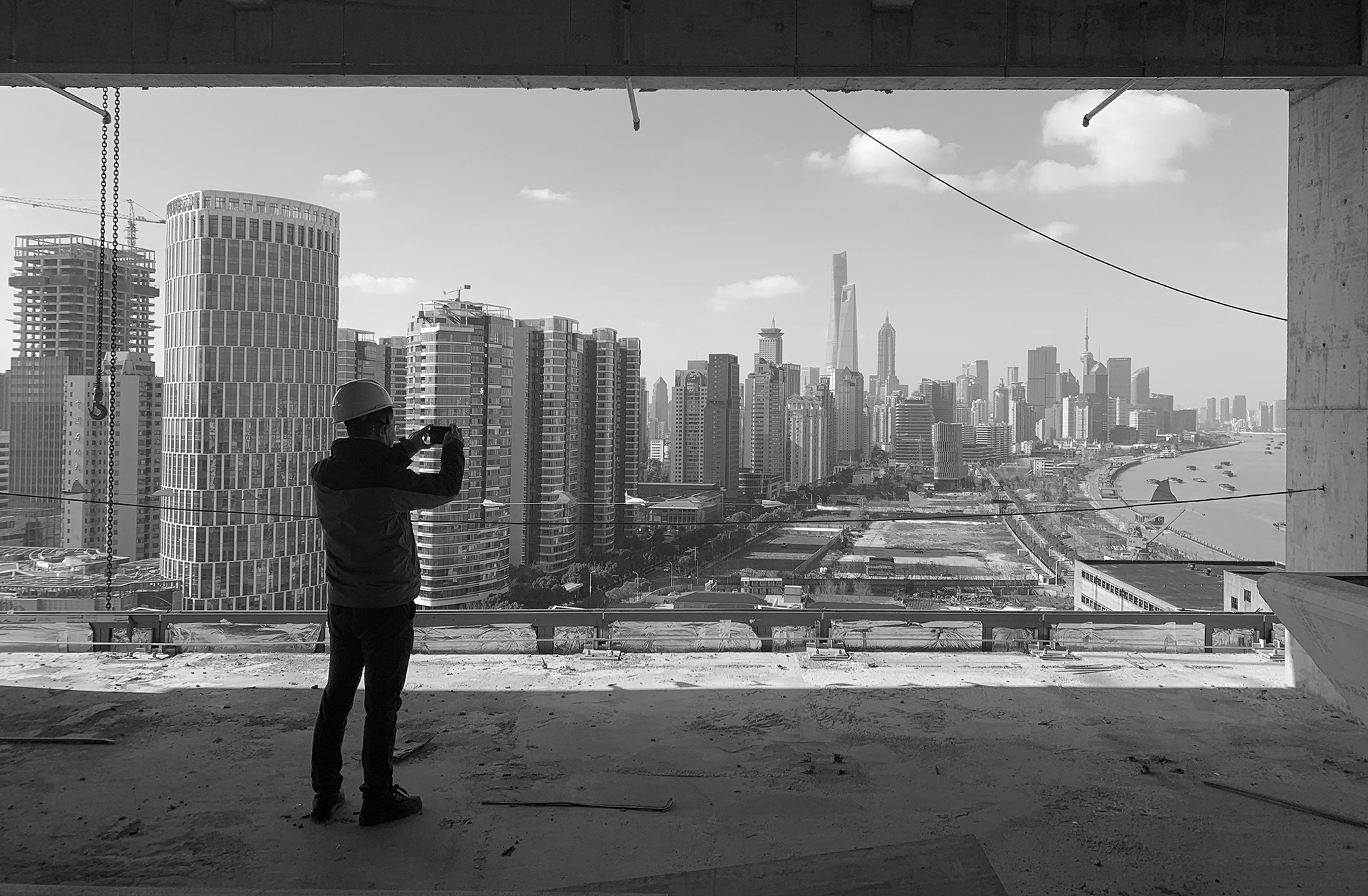
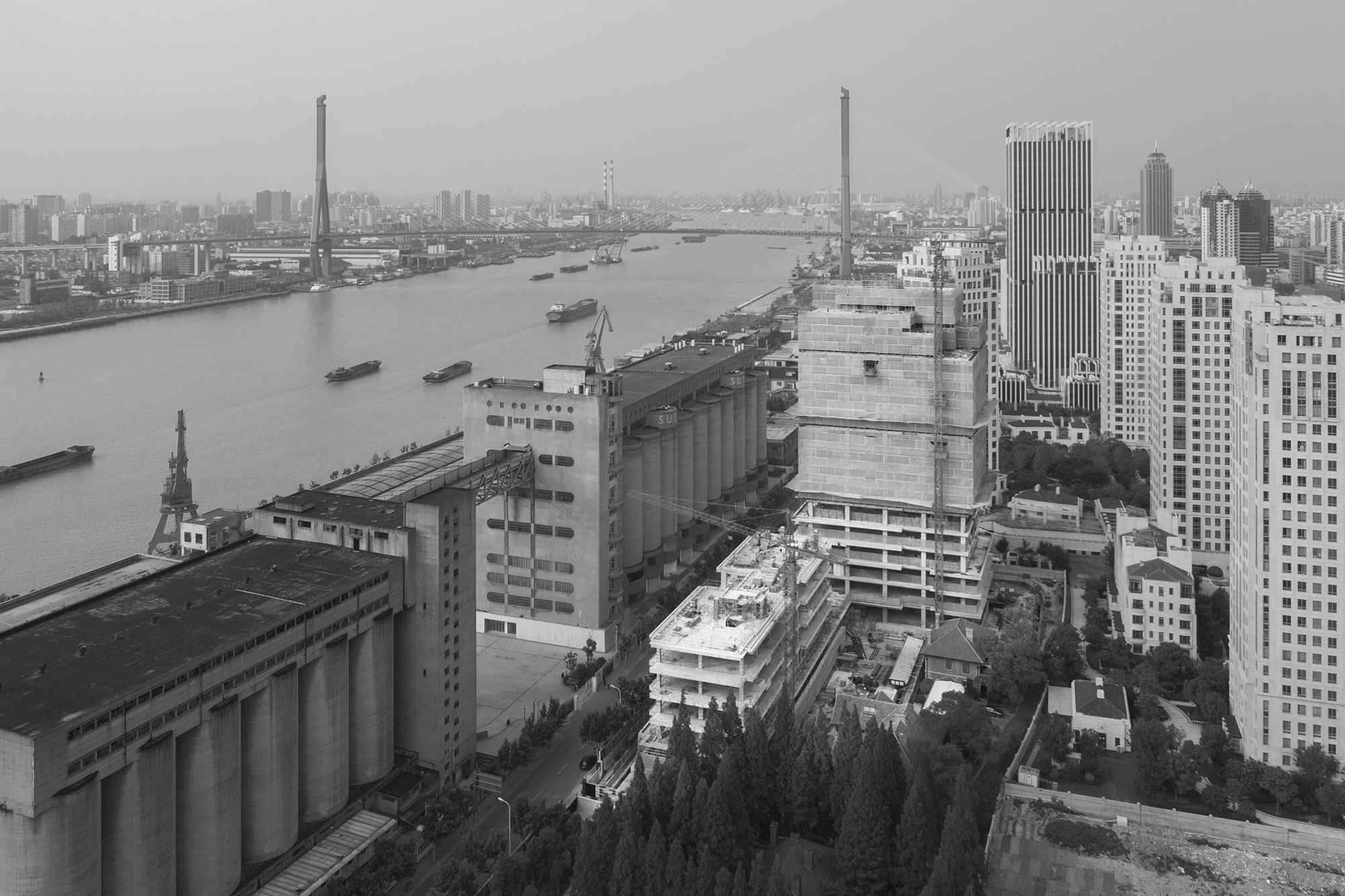

附文:项目英文介绍
Located at Minsheng Wharf in Pudong of Shanghai, Minsheng Wharf Block E15-3 designed by Atelier Ping Jiang/ EID Arch is a new waterfront development intended for urban regeneration. Primarily consisted of grade A office space and amenities, the project site is bookended in-between century old industrial silo warehouse, historical houses with landmark status and neoclassical luxurious residential neighborhood designed by American architect Robert Stern. With a GFA of 38,240 sqm, Minsheng Wharf Block E15-3 aims to create an urban structure that mediates and reconnects the complex urban conditions.
1 Urban Regeneration
The juxtaposition of these chaotic and complex urban conditions reflects the urban reality of the evolving city of Shanghai. By carefully addressing the complexity of these site conditions, the design of Minsheng Wharf Block E15-3 reestablishes a spatial order for the wharf. Negotiating with an L-shaped site configuration, the master planning includes not only a new addition of office building, also a temporary pavilion for arts and communal activities, along with renovation of three historical colonial houses. Working with strict site constrains, the organization of the new addition stems from the spatial relationship with surrounding buildings and urban environment, the solidity of the building is as critical as the voids. By correlating the massing and voids with the existing urban fabrics, a spatial fugue is created with new meaning and purpose, reactivating the industrial waterfront district.
2 Urban In-fill and acupuncture
The design ambition does not lie in creating an eye-catching spectacle building, on the contrary, it is intended to address the urban conditions in a restrained manner, providing a monolithic, minimal building responding and correlating to the surroundings. Inspired by the vertical rhythm of the silos, the building massing is articulated into four vertical tiers. To maximize the views towards the river and Lujiazui Financial District skyline, an offside core layout is adopted. A lower wing of the office/retail is place between the opening of the silo warehouse to allow for better river view and frontage. It also creates a pedestrian friendly urban experience. Porosity and permeability are introduced to the massing allowing for connectivity and interaction between the street and enclosed courtyard. Inside the office space, the design optimizes the overall height and creates a small floor plate ideal for daylighting. A series of landscaped gardens and terraces are placed throughout the office building to offer outdoor activity and interaction. In addition, the low rise wing of the building addresses the preserved historical colonial houses, forming a intimate street scale within the courtyard side of the block.
The superimposing of old industrial building and new architecture created a space-time dialogue with the waterfront sites. It's a dialogue between the new and old, history and modernity, preserving and inheritance. Some design features are inspired by the surrounding heritage buildings in terms of scale and materiality, the tower and the podium are connected by a slender horizontal corridor, which not only facilitates the circulation in the building itself, but also pay tribute to the industrial elements of the silos on the wharf.
The counterpoint in architecture and the framed scenery in Chinese traditional gardens are also apparent in this project. The four vertical volumes of the tower correspond to the verticality of the silo; the high on the east and low on the west section echo to the scale of surrounding buildings; the clear geometric division of the horizontal and vertical grids on the building facade take cues from the rich attributes of the industrial site...In the voids of the new building, with a casual glance, tenants and visitors could get the clear views of the surrounding landmark buildings, and the old and new are mutually framing views to each other.
3 Materiality, façade articulation
Unique from the traditional office building, Minsheng Wharf Block E15-3 selected Moroccan gray limestone and pressure-treated wood panel for podium base storefront facade, which is consistent to the concrete material palate of the silo; meanwhile, the vertical grooved line details on the tower façade adopted warm-tone material such as metal copper, which reflects the materiality of the surrounding historical building.
Further down the road, in addition to Minsheng Wharf Block E15-3, the architect also designed a clover-shaped temporary exhibition center and a renovated office building. While fulfilling the functional requirements of the buildings themselves, this project not only improved the urban fabric and structure, but also activated the previously deserted urban environment. These interventions have connected new commercial spaces, cultural/communal venues and residential neighborhood along the riverside. Through strategic urban in-fill and acupuncture, Minsheng Wharf is becoming a lively urban hub and cultural destination.
完整项目信息
项目名称:上海浦东民生码头E15-3街区城市再生
项目类型:城市更新、办公及配套
项目地点:上海浦东新区滨江大道
设计单位:EID Arch姜平工作室
主创建筑师:姜平,AIA
技术总监:陆生云
业主:中华企业/上海地产
设计时间:2015年12月—2017年10月
建设时间:2016年12月—2021年7月
街区面积:15,569平方米
办公地块面积:9,640平方米
办公建筑面积:38,240平方米
幕墙顾问:Inhabit英海特工程咨询(北京)有限公司上海分公司
景观顾问:瀚翔景观国际有限公司/上海兰境景观设计咨询有限公司
室内顾问:DU Studio 向和空间
标识顾问:Selbert Perkins Design博津思设计
灯光顾问:LEOX黎欧思照明(上海)有限公司
BIM顾问:中国建筑上海设计研究院有限公司
历史建筑改造:华建集团历史建筑保护设计院
施工图设计院:上海天华建筑设计有限公司
摄影师:是然建筑摄影、胡义杰、清筑影像
视频版权:EID Arch
版权声明:本文由EID Arch姜平工作室授权发布。欢迎转发,禁止以有方编辑版本转载。
投稿邮箱:media@archiposition.com
上一篇:住建部:不随意拆除具有保护价值的老房子
下一篇:广东彭湃中学汉京体育馆:全面开放的构筑 / 陈东华合伙人事务所